Updates from RDS Gallery
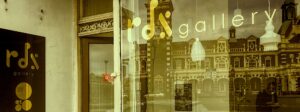

June 2025
PETER CLEVERLEY: BETWEEN TRANSIENCE AND ETERNITY
BY ALISTAIR FOX
About the Artist
Peter Cleverley was born in Oamaru in 1954 and works from a studio at his home in Kakanui, North Otago, having gained a Diploma in Fine & Applied Arts in 1974. As well as lecturing at the Dunedin School of Art since 1987 until his retirement, he has exhibited in Wellington, Ashburton, Gore, and Dunedin, including the recent ‘Zeitgeist: Works by Peter Cleverley’, curated by the Forrester Gallery, Oamaru, in 2023. His works are held in the permanent collections of many New Zealand public art galleries, including Te Papa; the Dunedin Public Art Gallery; Forrester Public Art Gallery, Oamaru; Suter Gallery, Nelson; Aigantighe Gallery, Timaru; Hocken Library, Dunedin; and the Manawatu Public Gallery, Palmerston North.
A painter who is strongly identified with the Otago region, working primarily in gouache and oil, Cleverley is noted for his vivid palette, oneiric imagery, and sustained, expansive, and deeply personal iconography.
About the Author
Alistair Fox is professor emeritus at the University of Otago, Dunedin, New Zealand, where he held a Personal Chair in English and also served as Pro-Vice Chancellor of the Division of Humanities. Born in Richmond, Nelson, he attended Waimea College, and gained BA Honours and Masters degrees at the University of Canterbury before being awarded a Commonwealth Scholarship to study for a PhD at the University of Western Ontario in London, Canada. His honors include the award of a Nuffield Visiting Fellowship to Claire Hall, Cambridge (1980–1981), appointment as a Visiting Fellow at All Souls College, Oxford (1987–1988), and an invitation to La Chaire Roger Odin at La Sorbonne Nouvelle in Paris.
Initially known for his scholarship on English Tudor literature, since 2008 Fox has turned to topics addressing cinema studies, art history, theories of literary and cinematic representation and Aotearoa New Zealand literature and culture. From 2019, he has regularly written catalogue essays, most frequently for RDS Gallery, Dunedin, which he owns (2020–current). Peter Cleverley: Between Transience and Eternity evolved as a consequence of two catalogue essays written for two exhibitions by the Otago artist Peter Cleverley, “Blue Daisy Chain” (9 October–7 November 2020) and “Never There Yet” (29 October–21 November 2021). This book extends Fox’s concerns defined in his earlier publications, which sought to explore the role of fiction, across media, in expressing the nature of self and identity, here within the context of Aotearoa New Zealand art history.
To order the book click here:
Copies are also available at bookstores and select galleries, including RDS Gallery for those of you located in Dunedin.
For more information contact us at:
contact@rdsgallery.co.nz
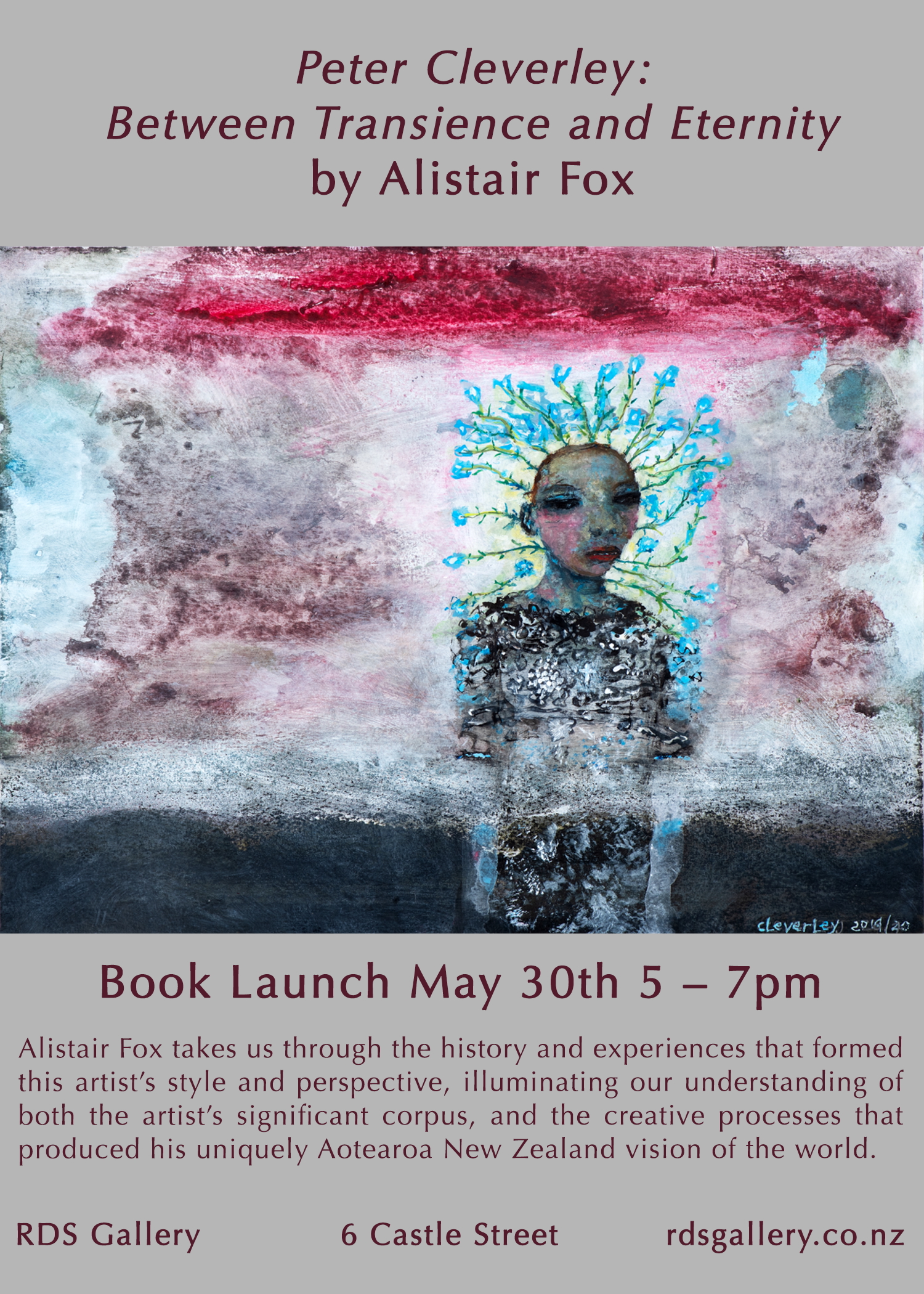
May 2025
To order the book click here:
Copies are also available at bookstores and select galleries, including RDS Gallery for those of you located in Dunedin.
For more information contact us at:
contact@rdsgallery.co.nz
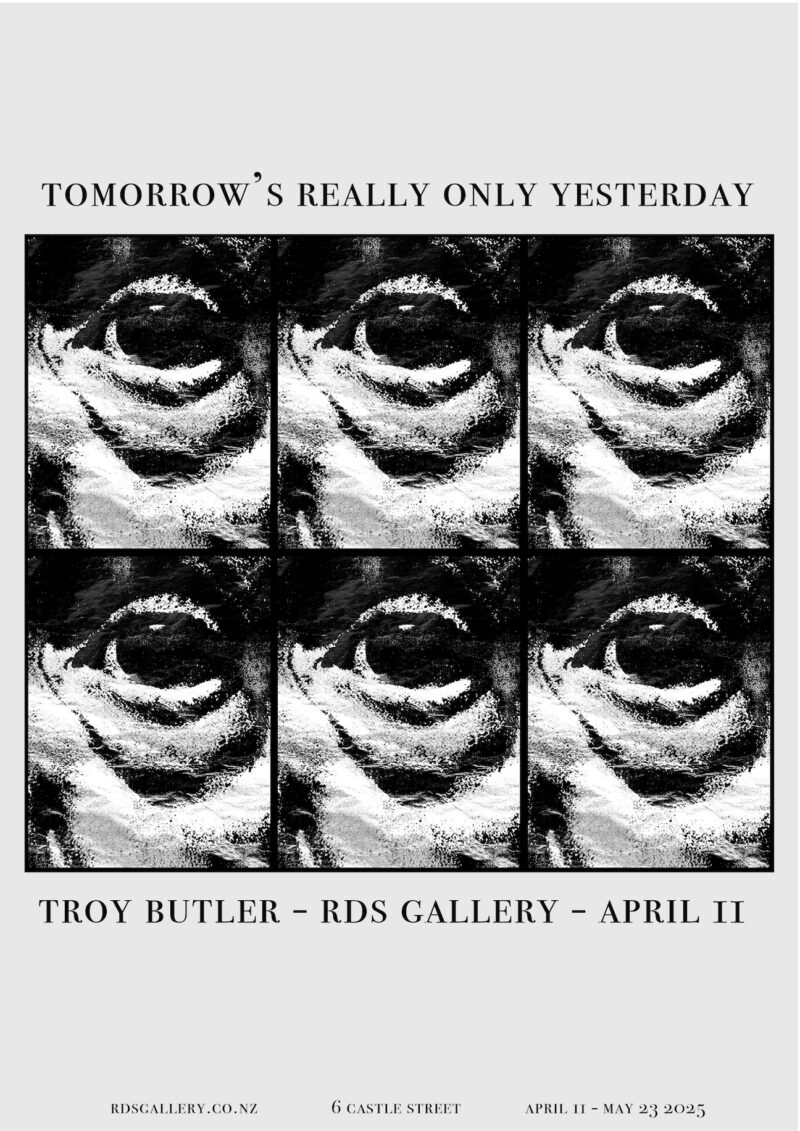
April 2025
Troy Butler: Tomorrow’s Really Only Yesterday
Tomorrow’s Really Only Yesterday, the title of Dunedin artist Troy Butler’s first solo exhibition, is an enigmatic phrase. In this context, it has several layers of potential meaning. At one level, it could refer to Butler’s printmaking practice, which seeks to use innovative new ways of exploiting the older technique of lithographic printmaking to recreate the effects of early photography. At a deeper thematic level, it could also allude to traumatic events in the past that continue to haunt the artist in the present. Finally, and not coincidentally, the first letters of the words in the title of this exhibition spell “TROY,” thus affirming the existence of a personal element inherent in these works. Like the prints themselves, the majority of which consist of two layers of silk cloth, each printed with an identical image, the one superimposed upon the other, Butler’s art is multilayered, and more complex than it might seem at a casual glance.
The exhibition consists of works drawn from three distinct series: the first a sequence of double-layered black and white prints showing a walk in the forest; the second comprising a cityscape contrasted with a rural landscape; and the third depicting close up enlargements of the faces of old men. At first sight, these three sequences might appear to have little to do with one another, but in actuality, they all derive from the artist’s desire to express a response to trauma.
Alistair Fox
Troy Butler: Tomorrow’s Really Only Yesterday opens Friday, 11 April 2025, 5:00 pm and runs through 23 May 2025.
To download the issue of our Occasional Essays series, published to accompany this exhibition, which includes an essay by Alistair Fox, click here:

6 April 2025
Ami Radunskaya
We bid farewell to Ami Radunskaya who has been in residence at RDS Gallery over the past month working on her project “In Conversation: Feedback loops and musical improvisation as recorded via computer,” in collaboration with Jon Cox, RDS Gallery Exhibitions Coordinator, and Dunedin musician and artist Motoko Kikkawa. Ami, who is a cellist and mathematician. returns to RDS Gallery in December 2025. Ami, you will be missed! We look forward to your December visit which promises more music and more brainwave recordings.
[Ami wears Black Grey Code Tunic by Company of Strangers, companyofstrangers.co.nz]
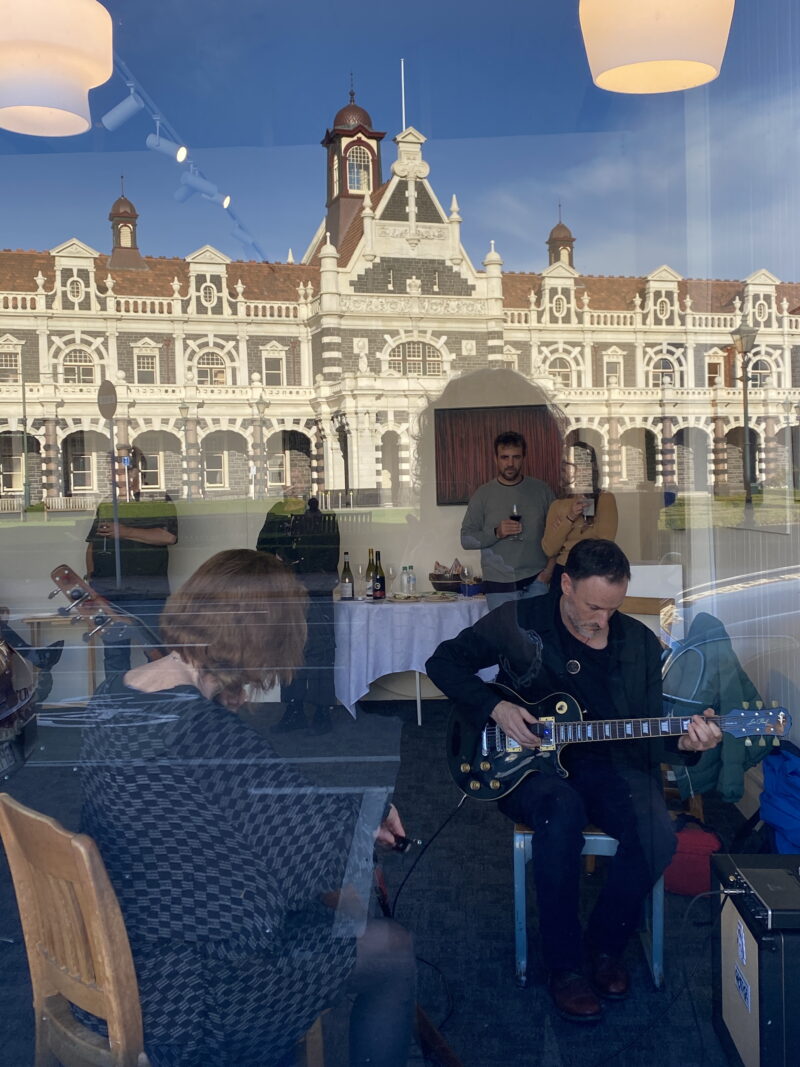
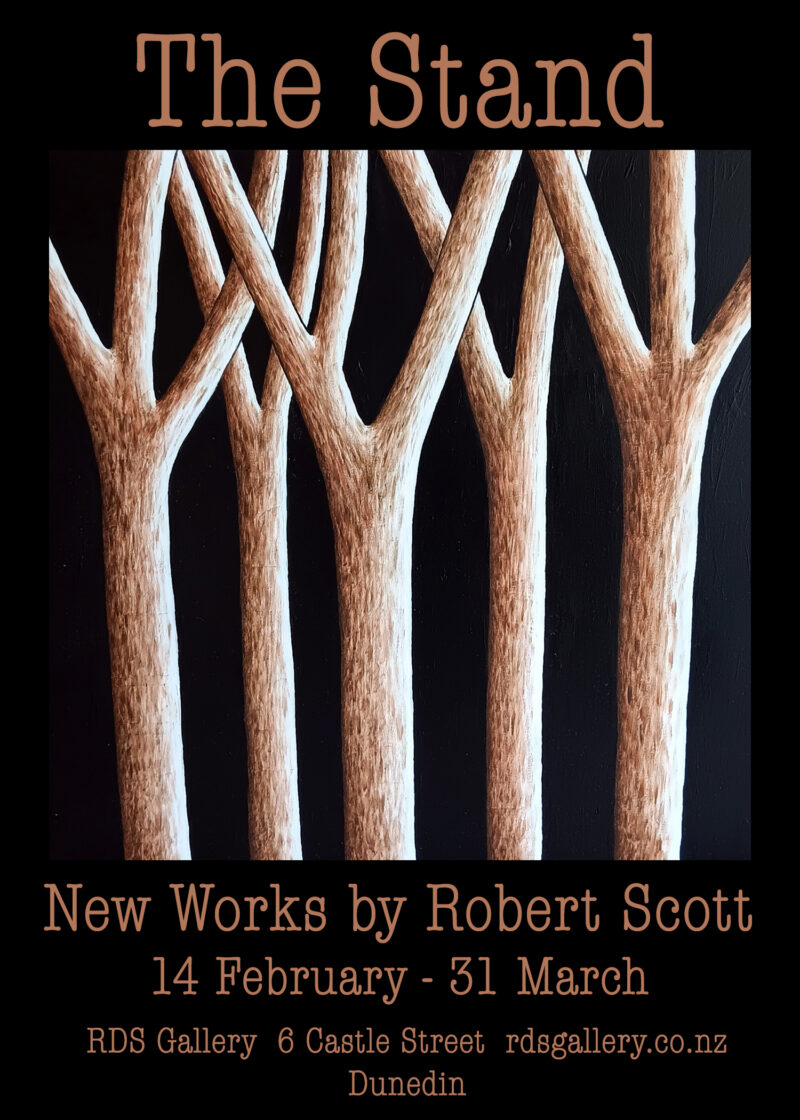
Robert Scott: The Stand
The apparent simplicity of Robert Scott paintings masks a latent complexity that emerges largely unconsciously through the process of painting. The imagery conveys both a sense of comfort – a safe place – and a creeping anxiety – suggesting the state of malaise that increasingly characterises twenty-first century culture. We long for a haven from the trials and tribulations of a world that seems to be slipping away from us into an incomprehensible chaos.
The precision and discipline with which these works are executed has a ritualistic accuracy. Concomitantly, Scott’s landscapes are marked by tropes and iconography that are familiar to South Islanders, that, nonetheless, incorporate phantasmic details, figures emerging out of his imagination – trees that are strange yet somehow familiar – the very essence of the unheimlich – the uncanny. The restricted yet colourful palette with which Scott works evokes a melody that is repeated with infinite and subtle variations. Viewers are invited to enter with the painter into this magical land. But we hesitate – we know that danger may lurk, its possibility behind each stand of trees.
Opens 14 February 2025
Note: Robert Scott will perform at Maggies, 46 Stuart Street, on Friday 28 February. For more information email: hello@maggiesotepoti.co.nz .
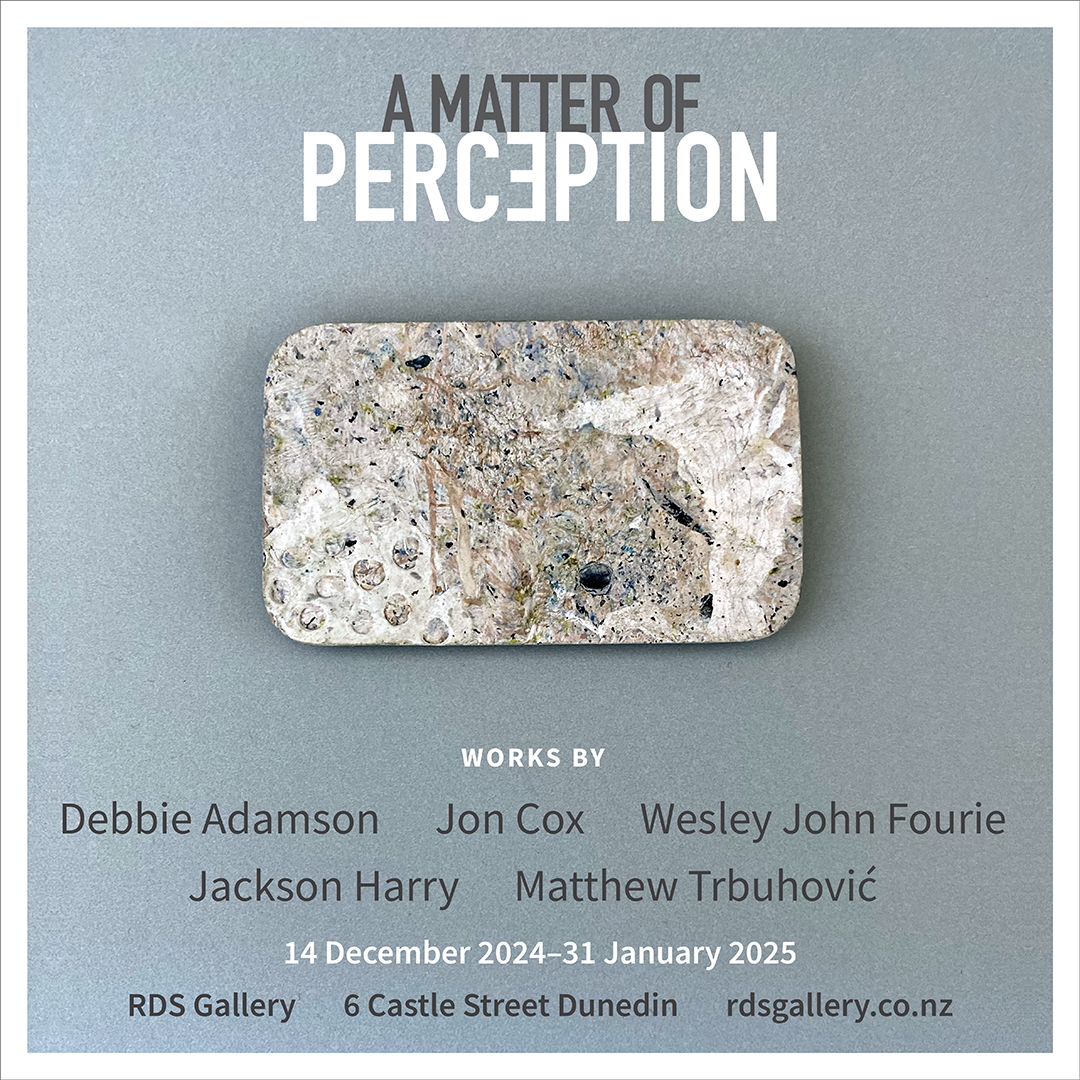
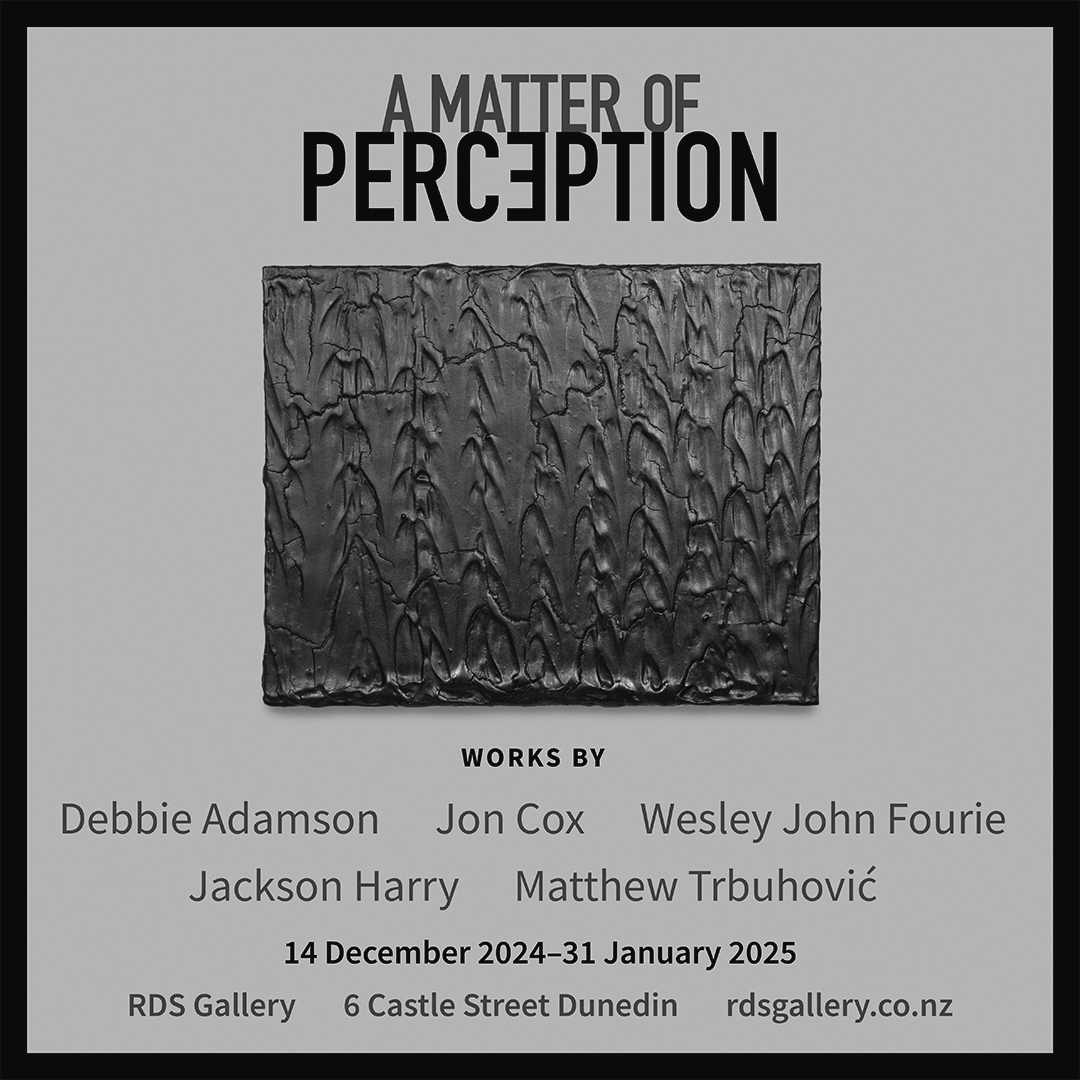
The group exhibition A MATTER OF PERCEPTION gathers together works that serve to call attention to the “stuff” that constitutes the art object, the material and perceptual qualities of the media deployed––its construction and its components. The art on view is, in and of itself, an invitation to observe, to contemplate, to engage in reveries….
Artists: Debbie Adamson, Jon Cox, Wesley John Fourie, Jackson Harry, Matthew Trubuhović
Open 14 December–22 December 2024, hours––11am–6pm
Closed 23 December 2024–7 January 2025
Open 8 January–31 January, hours––11 am–6 pm, Tuesday-Friday, 11 am–2 pm Saturday
For further information or to make an appointment: contact@rdsgallery.co.nz
* * * * *
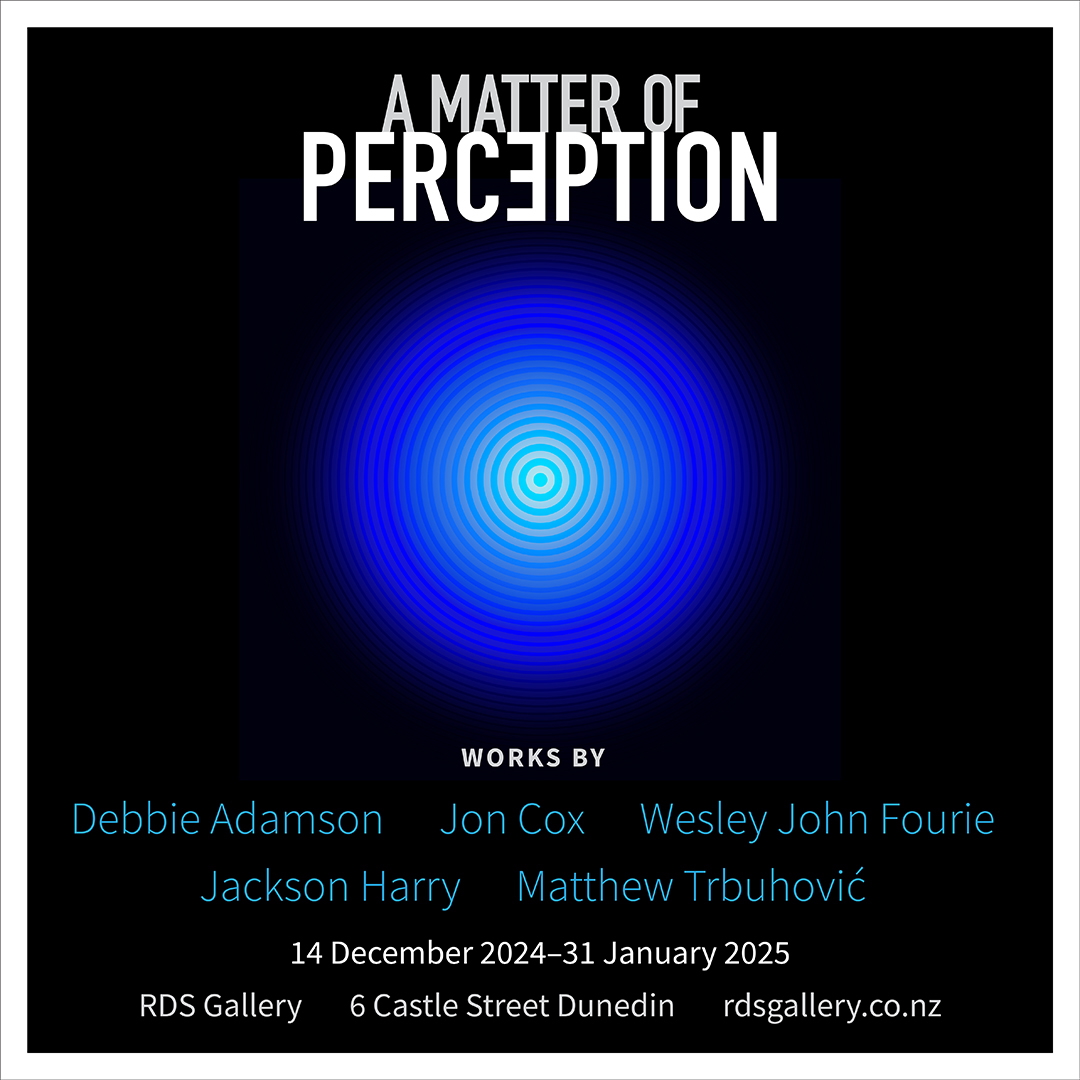
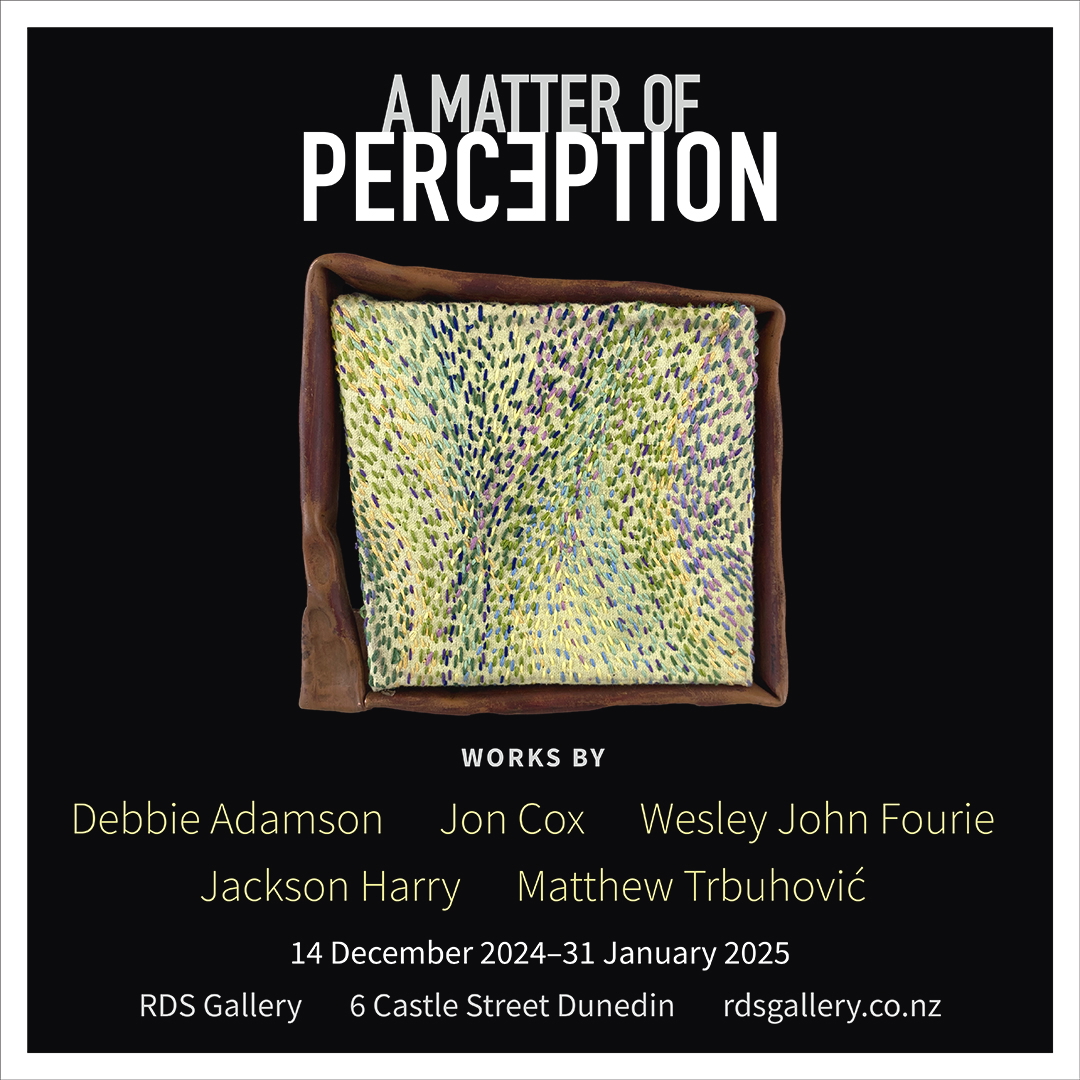
* * *
We have exciting news: Alistair Fox’s manuscript on the Otago artist Peter Cleverley’s life and work is now under contract with Quentin Wilson Publishing and is currently in production. We anticipate that the book will be available to the public in 2025.
Alistair Fox (born 1948 in Richmond, New Zealand) is a New Zealand scholar and writer who specialises in English Tudor literature and history, New Zealand literature and cinema studies, and contemporary literary and film theory, particularly with regard to national identity and the creative process. He has published over nine single-authored monographs in his career, most recently Melodrama, Masculinity and International Art Cinema (London / New York: Anthem Press, 2023). From 2019-2022, he has regularly written catalogue essays, most frequently for RDS Gallery, Dunedin, which he owned from 2020-2022. “Peter Cleverley: Between Transience and Eternity” evolved out of two catalogue essays written for solo exhibition by Peter Cleverley held at Rds Gallery, “Blue Daisy Chain” (9 October–7 November 2020) and “Never There Yet” (29 October–21 November 2021). This new book extends the concerns defined in Fox’s earlier work, in particular The Ship of Dreams: Masculinity in Contemporary New Zealand Fiction (Dunedin; Otago University Press, 2008) and Coming of Age in New Zealand: Genre, Gender and Adaptation in New Zealand Cinema (Edinburgh: Edinburgh University Press, 2017), here within the context of New Zealand | Aotearoa art history.
“Peter Cleverley: Between Transience and Eternity” traces Cleverley’s formation and evolution as an artist, identifying his early influences, which include inspiring teachers at Waitaki Boys High School and the Dunedin School of Art, an intensely religious family background, as well as extensive travels through exotic parts of the Middle East, Asia, and Europe that aroused in him a profound sense of the transience of human life and the paradoxical complexity of the human condition. Following a detailed consideration of Cleverley’s aesthetic principles and evolving practices, the book proceeds to analyse the different groups of paintings that have successively marked his career, from his early still lifes, through landscapes, to his more recent figurative work that focuses on the consequences of the mass movement of people across the world as a result of poverty and displacement.
While Cleverley’s work demonstrates affinities with his contemporaries in Europe and the United States, the Italian Transavanguardia, and American Neo-expressionism, his ethos and his aesthetic are intimately tied to his history and his location. The Cleverleys arrived in New Zealand in 1874, disembarking at Port Chalmers and settling a few years later in the Oamaru district, where the artist was born in 1954 and still lives today at the small seaside town of Kakanui.
The portrait that emerges shows Cleverley to be an artist who is both emotionally and aesthetically complex, having a sense of the human condition that has allowed him to convey it symbolically in a way that simultaneously captures not only the fragility of human life, but also its joys. In addition, his art communicates an appreciation of the beauty of this world and the gift of being alive, together with the value of art as a means of transcending mutability, making him a painter whose work is destined to be recognised as making an important contribution to the history of art in Aotearoa/New Zealand. Alistair Fox argues that Peter Cleverley’s oeuvre reflects the ethos of fourth generation Pākehā South Islanders. Informed by Christianity, but essentially secular,. Cleverley’s imagery is imbued with an enduring morality grounded in a sense of the value and fragility of life and the individual, set against the relative permanence of a landscape that is “always there.”
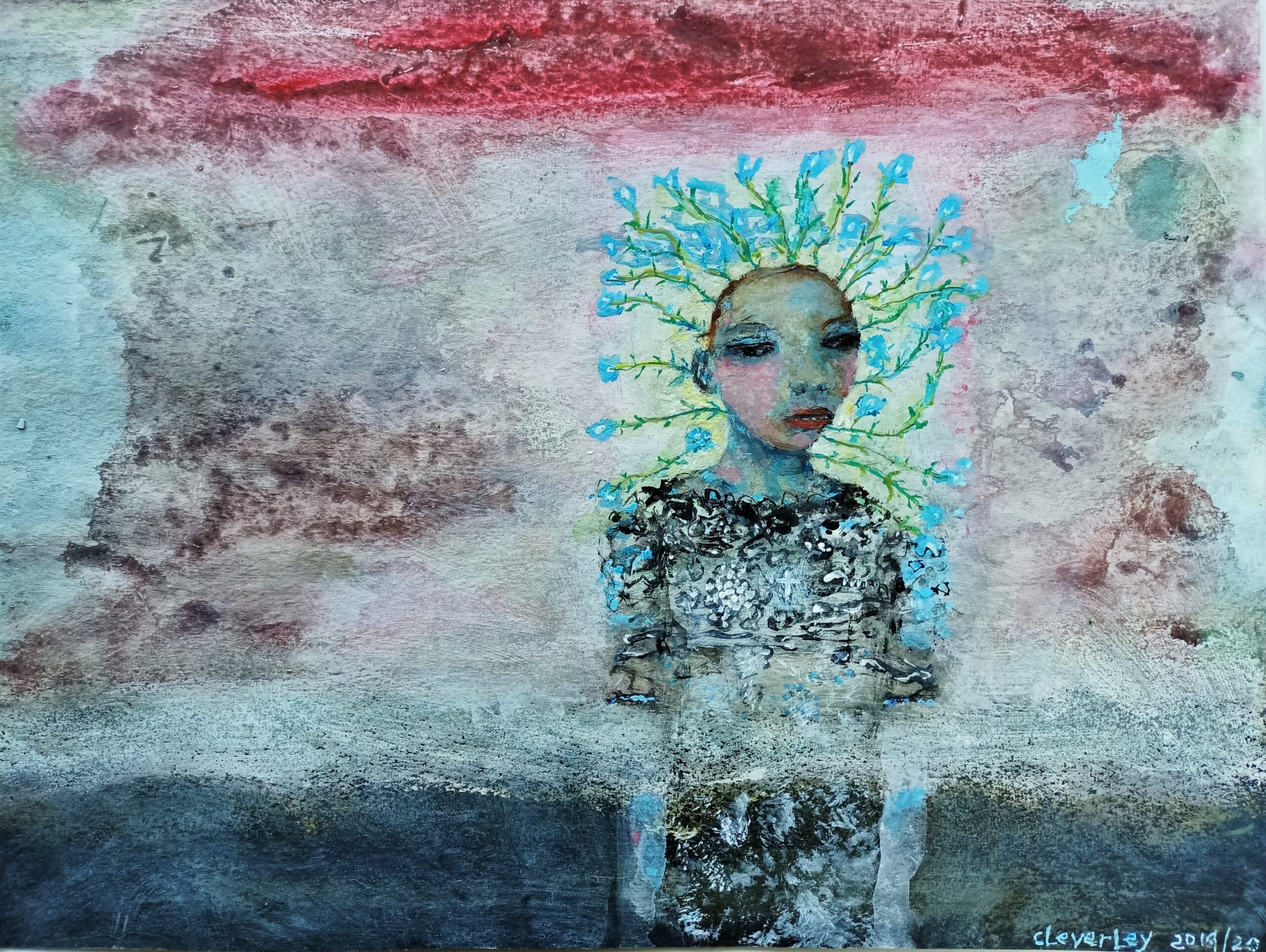
* * * * *
World Girl in Maniototo 2019/2021
Gouache and water colour
on d.a.s 300gsm paper
300 x 400 mm [unframed]
400 x 500 mm [framed]
For more information
on Peter Cleverley,
click the button below!
* * * * *
* * *
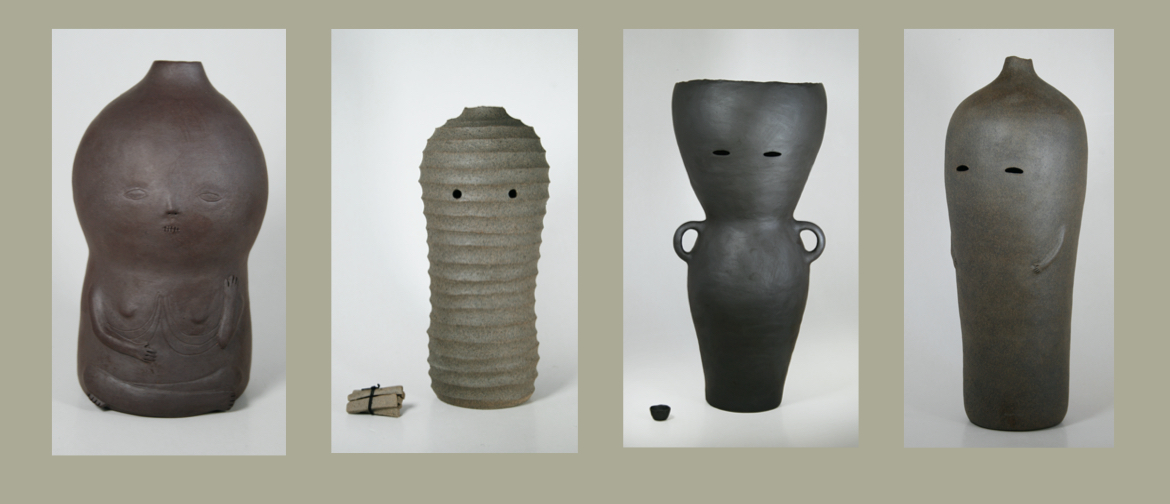
* * * * *
“Finger Grooves,” 2022, ceramic, 225mm; “Night Vase,” 2022, ceramic, 360mm; “Tall Grey,” 2022, ceramic, 350mm
* * * * *
30 September–29 October 2022
KATE FITZHARRIS
“COMPANION PIECE”
The artist Kate Fitzharris leads a thoughtful and well-examined life in Waitati with her husband and two children, working part-time as a librarian and exhibiting her art around the country at a number of galleries, while quietly building a national reputation as a New Zealand artist of note. She is the recipient of numerous awards and residencies, most recently the 2021 Premier Award at the Ceramics New Zealand Diamond Jubilee Exhibition held in Dunedin at the Railway Station and a 2021-2022 Waiclay Exhibition Merit Award (Waikato Museum). Kate uses her ceramics to share her values with others, to develop a common sensibility with those around her. She views her involvement in clay as a way to reflect upon 21st century culture. She explains: “Clay … it’s the earth … geological time … forces way beyond our powers. It’s also really ’domestic’ in that we use cups and bowls … and toilets. I am interested in both those histories.” This engagement in the materiality of ceramics, “clay,” provides her a means of staying honest: “For me to be healthy and happy, I need to remember I am a person in the world, rather than getting lost in my head. This also … links to environmental concerns––that we are part of this world, not separate from it.”
Drawing on her New Zealand childhood among two generations of creative women, and experiences such as her 2019 residency in Japan, Kate has developed a distinctive style, producing objects that are immediately at home in a domestic setting. Her abstract, and implicitly human, figures have an eery haunting quality, reminiscent of the traditional Japanese Kokeshi doll, beloved around the world, which Kate herself encountered in Japan. Reflecting on Kate’s creations, Cecilia Novero underlines their relations to the quotidian as “things” designed to accompany us––companions––that we look upon every day, our version of the Roman Lares and Penates. The materiality of these figures as of the earth––clay––resonates with contemporary concerns about the planet on which and through which we live. Novero writes: “Not only then do these everyday objects erupt in our lifetime from time immemorial; they also bring to the table, in all their beauty, the traces of the deep entanglements that make life––and stories––possible.”
Reference: Cecilia Novero, “Messmates at the Table!: From Companion Pieces to Companion Species,” KATE FITZHARRIS: COMPANION PIECE, ed. Alistair Fox and Hilary Radner (Dunedin, NZ: RDS Gallery, 2022), npn.
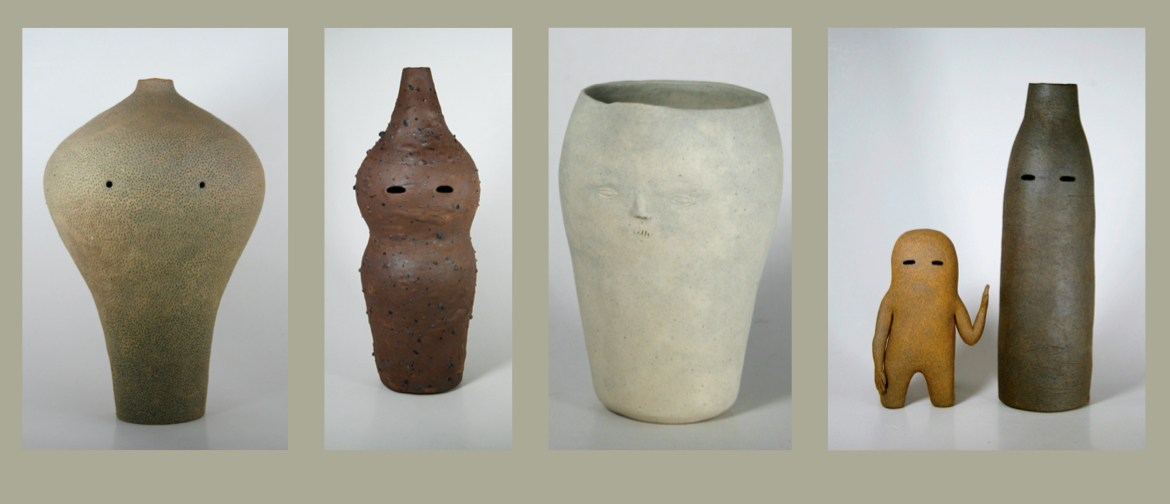
* * * * *
“Spot,” 2022, ceramic, 320mm; “Local,” 2022, ceramic, 315mm; “Milk Jug, ” 2022, ceramic, 115mm; “Companion,” 2022, ceramic, 245mm; “Blessing Hand,” 2022, ceramic, 175mm * * * *
For a catalogue of works on view click HERE.
For essays accompanying the exhibition by Hilary Radner and Cecilia Novero, click HERE.
* * * * *
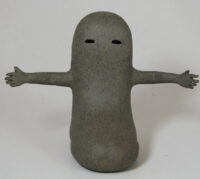
"You There," 2022

"Orange Marker," 2022
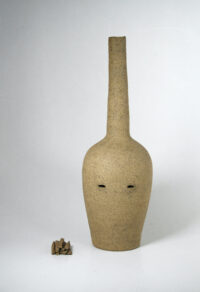
"Long Neck," 2022
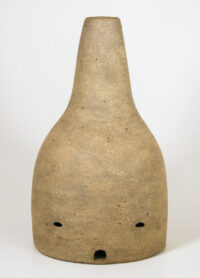
"Bottle Door," 2022
* * *
26 August–24 September 2022
Selected Works by Wesley John Fourie
“They Came to Me in the Night”
The exhibition “They Came to Me in the Night: Selected Works by Wesley John Fourie” (26 August–24 September 2022) brings together artworks produced through a diverse set of practices, from embroidery to oil painting. More significantly, the exhibition documents the artist’s experience over the past few years, resulting in what can only be described as an outpouring of expressivity. This exhibition records, in the words of fellow artist Felix Harris, a “journey, somewhat of a slippery slope at times, with its longing and heartache.” Bridie Lonie concurs, observing that “even as the artworks record moments of loss or difficulty, they are easeful and celebratory.”
Fourie explains: “This show is very much what I feel like is going on in my brain at the moment. Reflecting on old memories, insomnia, the lonely figures, trying to work through relationships with our rapidly changing natural environment…some bizarre sort of mourning, but in the happiest colours possible.”
This sense of loss permeates Fourie’s romantic reminiscences, but also his depictions of the forest, as a “dream” or a “ghost.” And yet, Fourie’s work is imbued with a stubborn optimism. In an embroidery exhibited in an earlier exhibition, the artist exhorts the viewer “BE KIND/STAY GENTLE/AND NEVER/BE AFRAID/TO LOVE.” Fourie eschews the violent rhetoric of current activism, asking us in a melodious and hopeful voice to consider our future together in a world that includes trees as well as humans. Not coincidentally, Alistair Fox reports that “[w]ithin the forest, Fourie tells us, there is “a spirit tree”––a gigantic kahikatea “that stole my heart more than any man ever has.”
As such it is difficult to disagree with Alistair Fox when he writes that “the works in this show provide ample testimony to an artist who has developed a distinctive personal vision of the inseparable interconnection between the affective lives of human beings and the natural environment in which they live.”
References ***Fox, Alistair and Hilary Radner, eds., Wesley John Fourie: They Came to Me in the Night. Dunedin: RDS Gallery, 2022 [with essays by Bridie Lonie and Alistair Fox].***Fourie, Wesley John, Felix Harris and Taarn Scott, Artists’ Kōrero. Dunedin: RDS Gallery, 2022.***Photography courtesy of Tia Ranginui and the artist.
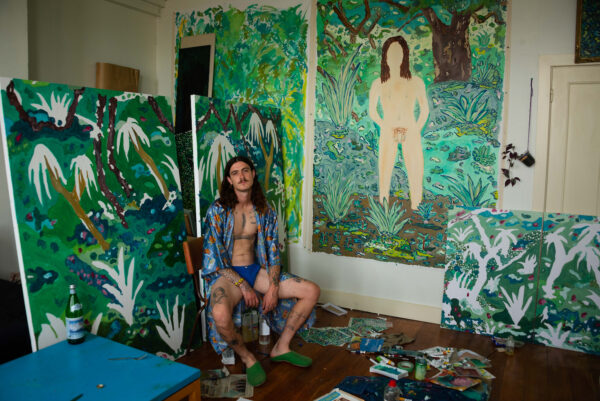
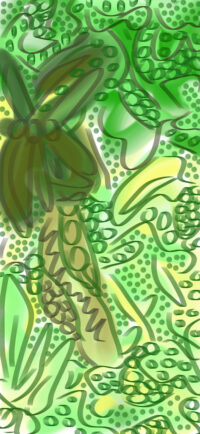
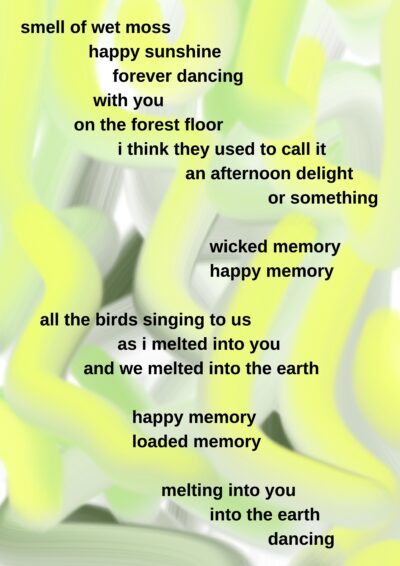
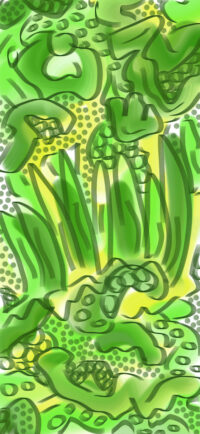
* * *
24 June–23 July 2022
Group Exhibition
“Shifting Channels”
WITH
Pippi Miller – Hemi Hosking – Wesley John Fourie – Taarn Scott – Hana Pera Aoake –
James Thomson-Bache –Troy Butler – Prudence Jopson
Open Wednesday, Thursday, Friday 11am – 5 pm, and by appointment. For an appointment contact us a radner@rdgallery.co.nz .
Click here for a catalogue of works available.
THE ARTISTS
Drawing and Painting
Pippi Miller (b.1997) was born in Te Whanganui-a-Tara | Wellington but grew up in Ōtepoti | Dunedin. She attended Logan Park High School, graduating in 2015. A scholarship swayed her toward attending University of Otago, and she emerged after four years of study in 2019 with a BA(HONS) first class in English literature, and an unexpected love for Dunedin. Pippi is currently enrolled in the MFA programme at the Dunedin School of Art, following on from the Graduate Diploma that she completed there in 2020. Her work was included in the 2021 exhibition at RDS Galley “Between Then and Here: Selected Works by the DSA 2020 Graduates.” Her drawing and painting-based practice focuses on exploring line and colour, illustration, and children’s literature.
James Thomson-Bache (b.1993) emigrated to Aotearoa | New Zealand in 2007 and settled in Ōtepoti | Dunedin in 2013, earning a BA in both Art History and Visual Culture from the University of Otago. His work has been selected several times as a finalist for the Parkin Drawing Prize held at the Wellington Academy of Fine Arts, his 2017 submission receiving a “merit” award. Self-taught in drawing, painting and ceramics, he draws on “art brut,” guerrilla art and abstract expressionism (his primary influences) to create detailed works with an emphasis on intuitive composition, improvisation and mark-making. He also employs surrealist “automatic drawing” as a recurring technique.
Printmaking
Troy Butler is an Ōtepoti-based artist, who has a day job running the successful Morning Magpie Café. Leaving an earthquake-stricken city for Ōtepoti | Dunedin, he not only found solace, but an embracing community. After spending several years establishing himself as a local business owner, with a view to supporting himself, he has recently returned to art-making as his first love. In his practice, Troy explores themes of identity through photo-lithographic printmaking as his principal means of expression. He deploys silk paper, mono-toned colours and dark dreamlike figures to examine and evoke journeys marked by a range of life themes. Significantly, through his practice, he continues to explore the effects of loss of identity.
Hemi Hosking [Hemi Hosking-Kereopa, Ngāti Tahinga, Tainui and Awhirio], born 1994 in Ōtepoti | Dunedin, holds a BA and Diploma in Visual Arts (2020) from the Dunedin School of Art. He is currently enrolled in the MA programme of that same institution, specialising in graffiti, typography and screen printing. He has previously exhibited at RDS Gallery in 2021 and was a finalist for the inaugural Kiingi Tuhetia portrait award, also in 2021, for a multi-media work representing Tāwhiao, Tūkāroto Matutaera Pōtatau Te Wherowhero Matutaera, to whom he is related. His work in the current exhibition at RDS Gallery focuses on reclaiming and rediscovering his Cook Islands | Kūki ‘Āirani heritage. He is also a local expert on New Zealand graffiti artists, to whom he credits his enthusiasm for the visual arts. You can find his work on his Instagram account @hemihosking.
Textiles
Wesley John Fourie (they, them) identifies as a queer artist whose multi-faceted art practice explores themes of nature, spirituality, and sexuality, predominantly through the use of textiles. The years that they spent in Ōtepoti |Dunedin had a formative influence on their practice and they regularly collaborate with Ōtepoti-based artists Taarn Scott and Hana Pera Aoake, including the recent exhibition “the future of dirt,” RM Gallery and Project Space (Tāmaki Makaurau | Auckland), June 2022. They were awarded the 2021 Molly Morpeth Canaday Youth Award and have been a finalist in the National Painting and Printmaking Award (2021), and the Wallace Art Awards (2020). Recent exhibitions include: “The Dance,” Window Gallery, University of Auckland, 2022; “i followed you Into the sea,” Whakatane Library & Exhibition Centre, Whakatane, 2022; “i dream a rain forest” at Malcolm Smith Gallery, Uxbridge Art Centre, 2022 and “From Across Bodies of Water and Other Transient Objects,” with Rozana Lee, at Gallagher Academy of Performing Arts, University of Waikato, 2022. Wesley are interested in creating a conversation around the preservation of our natural environment within the context of contemporary art. When not in their studio, they can usually be found somewhere in the bush.
Taarn Scott, an Ōtepoti-based artist, graduated with a BFA (HONS) from the Elam School of Arts, University of Auckland, in 2019. Recent exhibitions include: “the future of dirt,” with Wesley John Fourie and Hana Pera Aoake, at RM Gallery and Project Space (Auckland), June 2022; the solo exhibition “Outlining/Shifting Channels” at Refinery ArtSpace (Nelson), 2021-22; and the group exhibition “All Is Full of Love,” curated by Wesley John Fourie, Broker Gallery (Queenstown), August 2021. She is interested in illustrative practices, community art, and exploring drawing through a variety of media focusing on ideas around the body.
Sculpture/Multimedia
Hana Pera Aoake (Ngāti Hinerangi, Ngāti Mahuta, Tainui/Waikato, Ngāti Waewae)(they, their) is a mother, artist and writer. Hana works across many mediums and has published widely and sometimes organises exhibitions, readings, and conversations. Hana holds an MFA (first class) from Te Kunenga Ki Pūrehuroa | Massy University (2018) and was a participant in the ISP programme at Maumaus des escola artes (2020). Hana published their first book, A bathful of kawakawa and hot water with Compound Press in 2020. They live in Te Roto Pāteke | Macandrew Bay, Ōtepoti | Dunedin, with their partner and pepi studying Te Reo Māori. Currently they work with Morgan Godfery on Kei te pai press, a publishing and education project.
Recent projects include “the future of dirt,” with Wesley John Fourie and Taarn Scott, at RM Gallery and Project Space (Tāmaki Makaurau | Auckland), June 2022; “te tamaiti, te ao” at Artspace Aotearoa (Tāmaki Makaurau | Auckland), June–August 2022; “Neither Solid nor Liquid,” with Priscilla Howe, Te Tuhi Contemporary Art June–August 2022; as Kei te pai press, Matarau, group exhibition curated by Shannon Te Ao, City Gallery Wellington | Te Whare Toi, May–August 2022; as a contributor to the anthology The Material Kinship Reader, ed. Clementine Edwards and Kris Dittel, Onomatopee 208 (Einhoven, the Netherlands: Onomatopee Projects, 2022); Whānau Marama, Wynn Hamlin, group exhibition curated by Jade Townsend, Commercial Bay (Tāmaki Makaurau | Auckland), June/July 2021.
Prudence Jopson, born in Ōtautahi |Christchurch, is an Ōtepoti-based artist with a background in exhibition design. She has a deep understanding of the land and colour that surrounds her. Living in Melbourne for close to a decade, she attended RMIT School of Art, where she was awarded a Diploma in Visual Art (2017) and an Advanced Diploma in Visual Art (2018). Returning to Dunedin in 2019, Pru continues to explore the theme of growth and decay. Altering cement with various pigments and combining different textures, she achieves a highly resolved, diverse range of sedimentary sculptures. Recent exhibitions include the group exhibition “Mental Health––Response Received,” September–October 2021, in which she took a leading role as one of three curators, participating in the exhibition’s installation.
CLICK HERE TO DOWNLOAD THE BIOS OF THE ARTISTS INCLUDED IN THIS EXHIBITION.
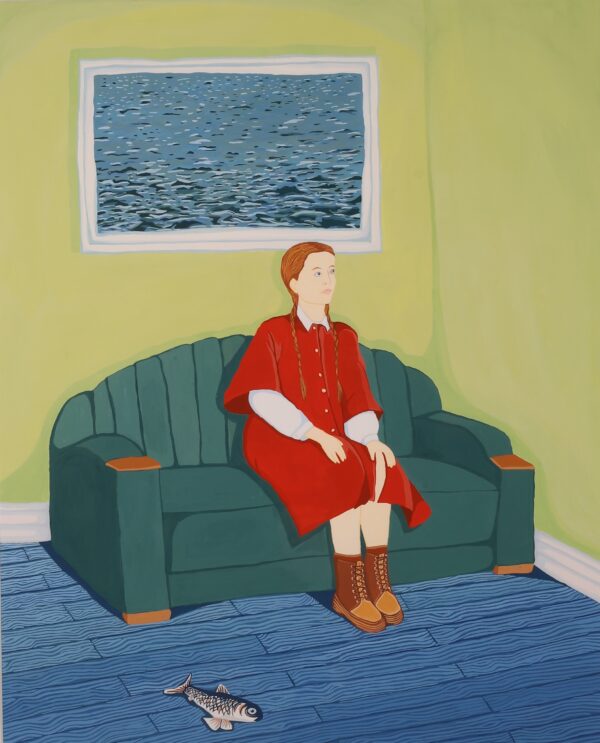
PIPPI MILLER, Dressing Up in Each Other’s Clothes, 2020, gouache on paper, 430 mm x 34.5 mm unframed, 590 mm x 490 mm, framed.
* * *
13 May – 18 June 2022
Rachel Hope Allan: Not Just Another Shinjuku Love Hotel
Open Wednesday, Thursday, Friday 11am – 5 pm, and by appointment. For an appointment contact us a radner@rdgallery.co.nz .
A significant dimension of Rachel Hope Allan’s work is an investment and attentiveness to photographic technologies and their cultural histories, extending to early photographic forms such as tintypes and ambrotypes. She has a special interest in what is often called “wet photography,” and is known for her work with a 1940s Linhof camera. The photographs included in “Not Just Another Shinjuku Love Hotel” are a more recent extension of these interests into digital technologies. She describes her concerns in the preface to coke and popcorn: the image and the series (Dunedin: Rachel Hope Allan, 2017), which includes reproductions of a number of photographs on view in the exhibition “Not Just Another Shinjuku Love Hotel.” Here, she defines her project as “…an attempt to negotiate the critical discussion around ‘high’ and ‘low’ forms of image making in the contemporary context.”
Shot on an iPhone over a period of years, during a number of visits to Japan, most recently, December 2019, the resulting images are “embedded within a contemporary dialogue that,” Allan explains, “explores the ritualistic act of photography itself.” Art historian Federico Freschi, thus, comments that “Rachel Hope Allan’s photographs present a quietly compelling alternative to the conventional travelogue….With their high-contrast, saturated tones and seemingly arbitrary compositions, they have a furtive, fleeting quality that evokes both the elusiveness of the moment and the instability of memory.” In the same vein, the photographer Lucian Howard underlines that “[f]or Allan the printing is as much a part of the creative process as capturing the image––every choice carries meaning.” By breaking with the current practice of reserving the photographic print for those images produced in a high culture context destined for the art world, as opposed to INSTA or FB, Allan blurs the borders between what she calls “‘high’ and ‘low’ forms of image making,” leading the viewer to reconsider these hierarchies.
The photographs in this exhibition bear all the marks of the artist’s sensibility, yet they also record her experiences as a traveller, an activity that links the series with contemporary populist practices. On the one hand, she documents the particularities of Japanese culture as one which, in historian Takashi Shogimen’s words, “…is characterised by the distinctive way in which it transforms foreign cultures it assimilates….It ‘Japanises’ them without exception.” On the other, her photographs are fully “autobiographical” in Lucian Howard’s terms, depicting “a particular vision of Tokyo that Allan has fallen in love with.”
RDS Gallery, May 2022
References
-Allan, Rachel Hope. coke & popcorn: the image and the series. Dunedin: Rachel Hope Allan, 2017.
-Fox, Alistair and Hilary Radner, eds., RACHEL HOPE ALLAN: NOT JUST ANOTHER SHINJUKU LOVE HOTEL, Essays on the Occasion of the Exhibition. Dunedin: RDS Gallery, 2022. [Includes essays by Federico Freschi, Lucian Howard, and Takashi Shogimen.]
For more information on this artist, including catalogues of works available, click HERE.
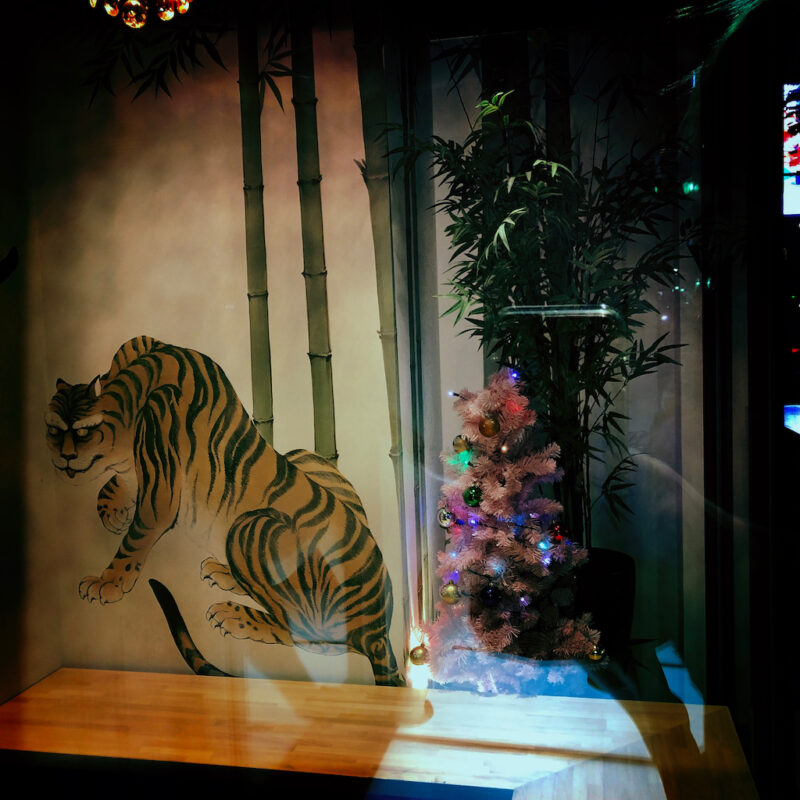
RACHEL HOPE ALLAN, PRETTY ON THE INSIDE (2020), 1000 mm x 1000 mm
* * *
“Felix Harris: Magical Thinking”
RDS Gallery, 6 Castle Street, Dunedin
11 February – 12 March 2022
EXTENDED THROUGH SATURDAY 2 APRIL
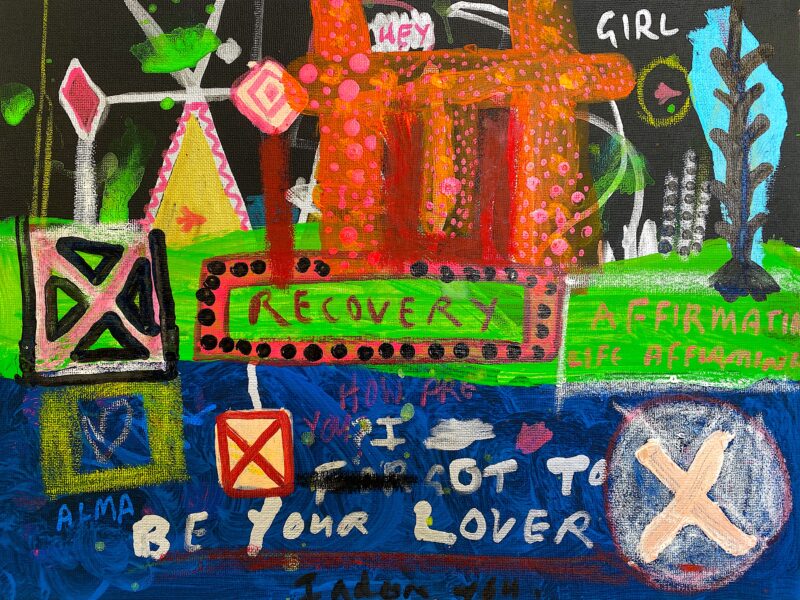
FELIX HARRIS, “Alma,” 2021, acrylic and oil pastel, canvas board, 30.5/40.5 cm.
The exhibition “Magical Thinking” (11 February–11 March) invites the viewer to explore a set of fifteen vivid and colourful paintings by Dunedin artist Felix Harris produced during the years 2019–2021. According to Gregory O’Brien, 2012 Arts Foundation Te Tumu Toi Laureate, Harris, who draws on a diverse set of references, including “Joan Miró, Denis Diderot, Roland Barthes, William Blake, and the Beats,” mobilises “disjunctive colours, patterns, and pictorial discontinuities” to “impart a sense of strangeness and heightened awareness.” Similarly, Taarn Scott comments that this artist creates a “world” in which “he is the king” as he “does not let aesthetic determinations, or the privileging of certain voices or hierarchies take control.” Harris offers something akin, deems O’Brien, to “maps whose purpose is to help the map-reader get lost”––enacting the paradox of “Expressionist painting” as a “deluge of life-affirming colour, form and movement while imparting a tragic or violent vision of life.”
Felix Harris (b. 1978, Dunedin, New Zealand) graduated from the Elam School of Fine Arts in 2006, continuing his education with a Bachelor of Art and Design (Honours) from Auckland University of Technology (2014). Felix has travelled extensively overseas and was based in Seattle, Washington 2007-2009. An active visual artist, he has worked as a producer/emcee under the name “fatigue,” with contemporary music continuing to play an important role in his life. Significant influences include Mexican Folk Art and Muralists, as well the work of cartoonist Robert Crumb and the writings of Charles Bukowski.
References
Gregory O’Brien, “Vestibules of a Heavenly Conspection—Paintings by Felix Harris,” in, ed. Alistair Fox and Hilary Radner, Felix Harris: Magical Thinking (Dunedin: RDS Gallery, 2022), 1-4.
Taarn Scott, “The Dreamscapes of Felix Harris,” in, ed. Alistair Fox and Hilary Radner, Felix Harris: Magical Thinking (Dunedin: RDS Gallery, 2022), 5-7.
* * *
“Murray Eskdale: Perspective”
RDS Gallery, 6 Castle Street, Dunedin
14 January – 5 February 2022
Wednesday–Friday, 11am–5pm; Saturday 11am–1 pm.
The exhibition “Murray Eskdale: Perspective” (14 January – 5 February) explores the relations between “the object world” (objects as they exist outside the self, in the “world”) and the digital image. Eskdale’s approach takes its inspiration from the tradition known as “New Objectivity,” inaugurated in 1920s Germany, in particular, its more recent iterations expressed in the work of Hilla and Bernd Becher (1934–2015, 1931-2007) and that of their students, most notably Andreas Gurksky (1955–present). As such the photographs in the exhibition “navigate between the artificiality of the object world and its equally inauthentic digital representation,” in the words of Philip Madill. Two groups of photographs, one depicting Hong Kong architecture, the other Dunedin, provide, again quoting Philip Madill, “a framework for representing the contrasting effects of urban design.” As such, explains Madill, “the show presents us with a question when confronted with the reality of the digital image. Which reality are we experiencing? That captured by the camera, the viewer, or the artist?”
References
Philip Madill, “New Perspectives: The Photography of Murray Eskdale,” in Murray Eskdale: Perspective, ed. Alistair Fox, and Hilary Radner, published on the occasion of the exhibition “Murray Eskdale: Perspective,” 14 January – 5 February 2022, RDS Gallery (Dunedin: 2022).
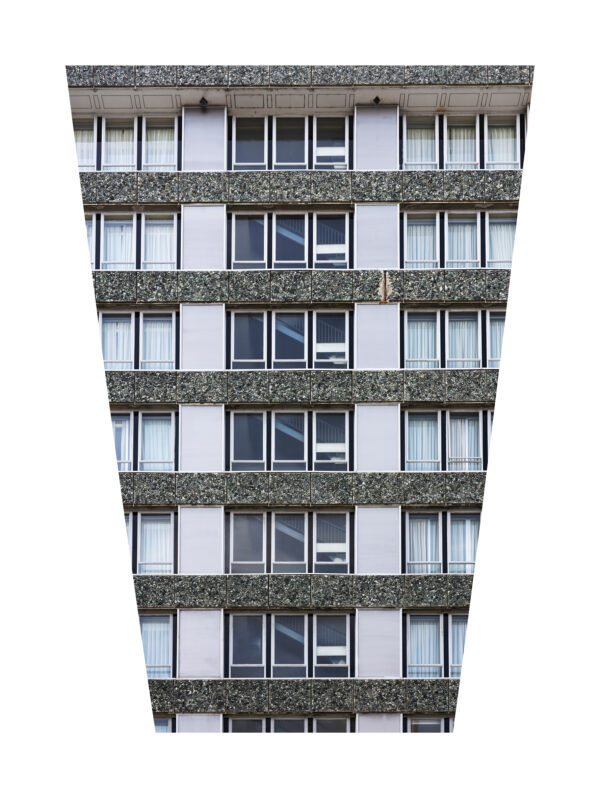
MURRAY ESKDALE, “Scenic Hotel,” photograph, 1/3, 915x1220mm, photo 2021/print 2021.
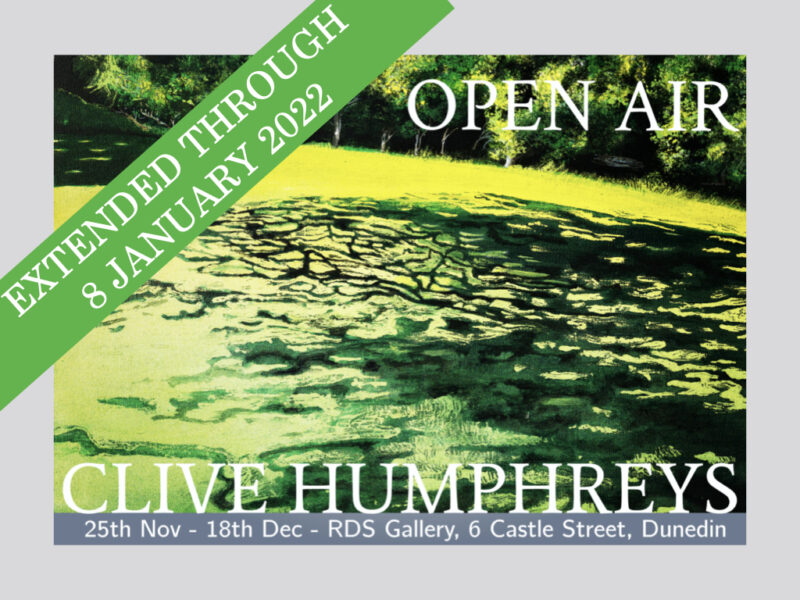
* * *
“Clive Humphreys: Open Air 2021”
RDS Gallery, 6 Castle Street, Dunedin
25 November–18 December 2021
Wednesday–Friday, 11am–5pm; Saturday 11am–1 pm.
Clive Humphreys will be well-known to many through his association with the Dunedin School of Art, where he taught from 1987 to 2019. “Open Air 2021,” his first exhibition in Dunedin for many years, consists of a series of luminous treescapes painted in acrylic on canvas and paper that mark a new departure for the artist. After ten years of preparing for this series by making monochrome charcoals and watercolours to grasp the tonal values of forest light, Humphreys now puts that knowledge to use in colour by building colour in translucent layers to capture shifting colour values within shadow, reflected colour, and cast colour. His focus is on the ancient pohutukawa trees that stand in open spaces on the outermost edge of the bush near the ocean in a small area of Whakanewha Regional Park on Waiheke Island. He affirms that the paintings are not so much about the place, as his relationship with the forest architecture. Citing a passage from an essay by John Fowles, Humphreys declares his credo: “The deepest thing we can learn about nature is not how it works, but that it is the poetry of survival. The greatest reality is that the watcher has survived and the watched survives. It is the timeless woven through time, the cross-weft of all being that passes. Nobody who has comprehended this can feel alone in nature, can ever feel the absolute hostility of time.” The paintings in this exhibition offer a striking testimony to the truth of this statement.
For more about this artist and the works included in this exhibition, click here.
Peter Cleverley: Never There Yet
RDS Gallery, 6 Castle Street, Dunedin
29 October–20 November 2021
Wednesday–Friday, 11am–5pm; Saturday 11am–1 pm.
Peter Cleverley has secured himself a place in the history of New Zealand art: for over forty years he has been painting in his native Oamaru. He continues to create in a tiny studio located in Kakanui, whose variegated skies, blue seas and “horseshoe bluff” mark his work, providing, along with his many travels, “the matrix” for his art, in the words of Hal Smith, writing for Art New Zealand in 1988. Peter Cleverley is indeed a regional artist in the sense that he is of the region, “a product of our own patch of earth,” again from Hal Smith. His concerns are, nonetheless, global, as he continues to explore what he calls “the human condition” in all its complexities. His current exhibition “Never There Yet” (29 October–20 November 2021) revolves around the theme of dislocation in the contemporary world, arising in response to “the legacy of several centuries of imperialism and of the increasing mobility of people around the globe,” as Alistair Fox puts it. Similarly, Heather Bauchop describes “the lone figures” in Peter Cleverley’s current paintings as “displaced…they stand, indeterminate, translucent, above the void.” These unfamiliar images refuse categorisation, having more in common with each other than with any external references. They serve to evoke the poignant, unresolved emotional realities experienced by dislocated individuals who must rely on the mercies of an indifferent universe.
References
Bauchop, Heather. “Getting There––a Visit with Peter Cleverley,” in Peter Cleverley: Never There Yet, edited by Alistair Fox, and Hilary Radner, 1–8. Dunedin: RDS Gallery, 2021.
Fox, Alistair. “Traversing the Space In-Between: Peter Cleverley’s Art of Translocation” in Peter Cleverley: Never There Yet, edited by Alistair Fox, and Hilary Radner, 9–12. Dunedin: RDS Gallery, 2021.
Smith, Hal. “Peter Cleverley,” Art New Zealand 47 (Winter 1988): 72–75.
To download a copy in PDF of the essays published on the occasion of this exhibition, click on the button below.
Soft cover copies will be available in the gallery during opening hours.
Click on the button below for a catalogue of all works included in the exhibition in PDF format.
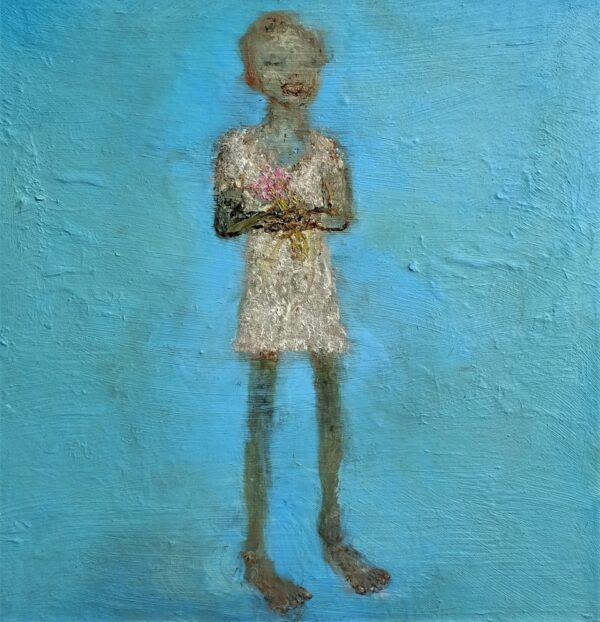
* * *
PETER CLEVERLEY, The Sea Walker (2021), oil on board, 342mm x 342mm framed.
Michael Greaves – Selected Works: 2013–2016 * 6-23 October 2021
RDS Gallery is pleased to announce “Time steals some things, but gives us back others.” (6–23 October), an exhibition of work by Michael Greaves from the years 2013–2017. The idea of the exhibition arose when Clive Humphreys, initially scheduled to exhibit 1 October–23 October, found himself (with his work) locked down in Auckland, and was consequently obliged to defer his show “Open Air.” Michael kindly plundered his archive for us, thereby offering viewers a rare opportunity to explore the aesthetic journey that he has undertaken as an artist over the past decade. Drive by 6 Castle Street for a glimpse of some of Michael’s more dramatic works – or visit us in person (level 2.5 policies apply) between 11-5 Wednesday through Friday, 11-1 on Saturday. If you prefer a private visit, to arrange an appointment, contact us at radner@rdsgallery.co.nz.
Michael Greaves (b. 1976) currently lives and works in Dunedin where he graduated from The Dunedin School of Art at Otago Polytechnic in 2017 with a Masters of Fine Art (Distinction) and holds the position of Senior Lecturer in Painting. He has exhibited nationally, and internationally, and has work held in the James Wallace Arts Trust, the Otago Polytechnic Collection and in numerous private collections in New Zealand, Australia, the United Kingdom, the United States and Europe. Recent work by Greaves has been exhibited in Berlin, Auckland, and Dunedin.
Pete Wheeler: Longer Than Dirt, scheduled for 3–25 September 2021, has been deferred due to lockdown restrictions.
Below a preview of one of the very striking paintings included in Longer Than Dirt
* * * *
Check under Artists for a downloadable catalogue and occasional essay in PDF.
PETE WHEELER, Getting Old Sucks, 2021, oil, oil stick and pigment on canvas, 11700mm x 2200mm.

Esther Bosshard
Rona on the Moon
6–28 August 2021
Opening Reception: 6 August, 5-7
radner@rdsgallery.co.nz
The exhibition “Rona on the Moon” brings together selected paintings from 2018 through 2021 by Dunedin artist Esther Bosshard. Largely landscapes and seascapes in oil on canvas, hessian, and board – the largest work is 61xcm in height and 100cm in width, with most considerably smaller – the majority were completed in 2021. Edward Hanfling’s description of a 2018 exhibition continues to ring true: “There are paintings…that conjure figures and animals out of delicate ridges and flicks of paint…. [E]very part of the surface holds interest. The eye is drawn into minute vistas with indeterminate suggestions of matter, then back to the matter of paint itself.” Jane Malthus observes in the context of this 2021 exhibition that “Esther’s paintings freeze time, but also render landscape, beach, and moonlit seascape as both aged and ageless. They remind us of nature’s diurnal rhythms and seasonality, and, thus, our own timespan of life.”
References
Edward Hanfling, review of “Esther Bosshard: My hair is longer and the plums are ready now.”, ART NEW ZEALAND 166 (winter 2018): 48.
Jane Malthus, “Rona on the Moon,” ed. Alistair Fox and Hilary Radner, ESTHER BOSSHARD: RONA ON THE MOON, Dunedin: RDS Gallery, 2021.
Artist’s Biography
Esther Bosshard (b. 1994 in Wellington) spent three years studying painting at the Dunedin School of Art and completed a Bachelor of Visual Arts in 2015. In a world she sees as increasingly fragmented, chaotic, and noisy, her paintings are a manifestation of her quest for a simpler, quieter meditation on life, paying homage to the modest overlooked objects and landscapes in our lives. She has always been interested in the conceptualisation of the everyday in painting, because, in her words, “I love the myriad of detail, colour, pattern, form and light that we live amongst and remain largely oblivious to. My paintings, I hope, encourage introspection, recognition, and at the very best, the opening of the eyes of the viewer to the incidental beauty in his or her own life.” A recipient of the 2015 Feldspar Scholarship and the 2015 Webb Farry Award for drawing, she, as well as painting and growing flowers, also teaches life drawing at the Dunedin School of Art night classes.
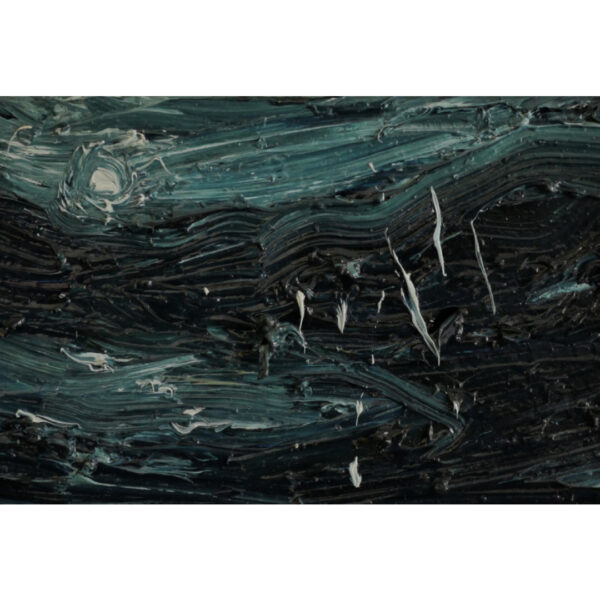
ESTHER BOSSHARD, Dunedin Harbour, Night-time, Rain (2021), oil on wood, 90mm x140mm.

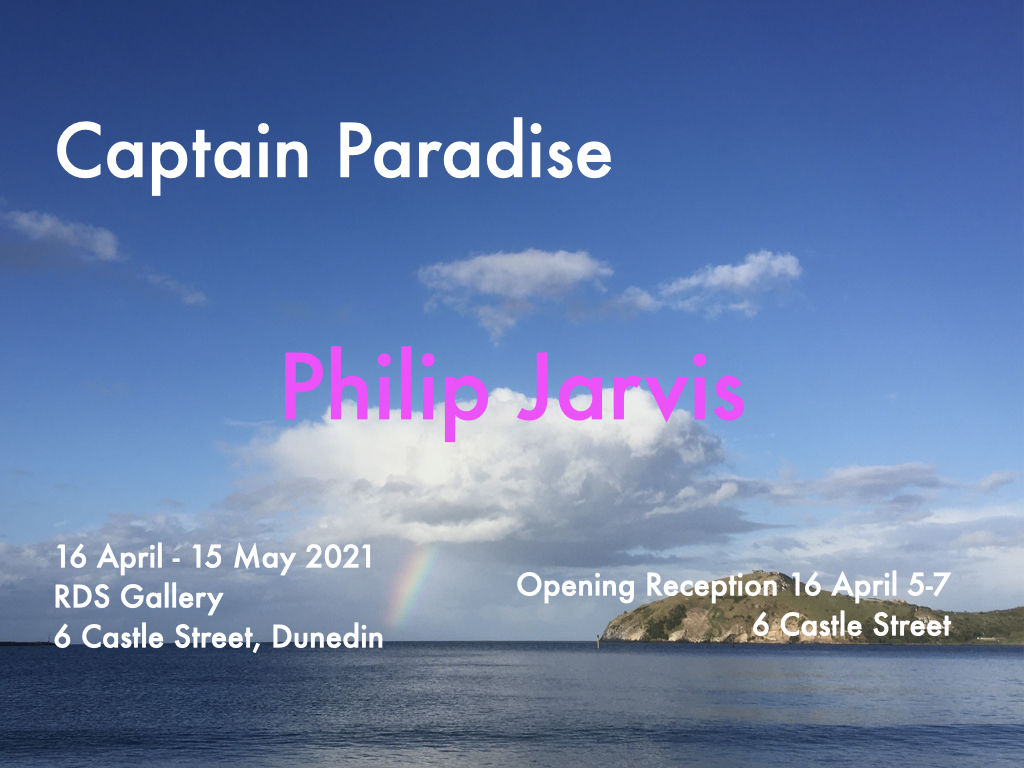
Philip Jarvis: Captain Paradise
16 April – 15 May 2021
Opening Reception: Friday 16 April, 5-7 pm
RDS Gallery, 6 Castle Street
rdsgallery.co.nz
Philip Jarvis is perhaps best known for his ceramics, though his projects could be described as ‘3-D work that crosses a range of disciplines’, exemplified in the recent ‘Cargo Bike Art Project’ (2021) with Anna Muirhead for the Dunedin Fringe Festival. The art included in ‘Captain Paradise’ ranges from ceramics to photographic collages. Philip comments, ‘Ceramics are always the starting point, but as I work more with ceramics, I want more control and gravity – this means using less of the kiln and bringing in other materials, including photographic images.’
A concept that returns again and again in conversation with Philip is something he calls ‘the Art of Being Visible’ – an idea that underlies his exhibition at RDS Gallery (16 April – 15 May 2021) titled ‘Captain Paradise’. Philip explains: ‘When you are a kid, lots of times, you dream about being someone. And…then, you just invent a character…and then you can talk about things through the character that you probably wouldn’t have the courage to address otherwise. “Captain Paradise” is an exploration of that…inventing a character.’ Pippi Miller in her occasional essay accompanying the exhibition emphasises that a ‘tension…between visibility and invisibility, distraction and vulnerability’ informs the works on view, a tension that speaks to the difficulty of ‘being someone’ in contemporary society, in which behaviour and appearance are increasingly on trial, subjected to scrutiny and frequently condemned out of hand. Jarvis concludes, ‘The exhibition “Captain Paradise” is an invitation to enter into my world. The whole point is to come into a space [that may be] in some ways overwhelming because it belongs to me, at least temporarily…[The exhibition is] an invitation to the viewer to enter the space that I have created.’
Philip Jarvis (b. 1968) completed a BA at the Camberwell School of Art (1987-1990). Born in Winchester, U.K., he has spent the last 24 years making art in Dunedin, which he considers his home. He has been awarded numerous residencies, including the Cowwarr Art Space (2016, Victoria, Australia), the Lochmara Lodge Artist Residency (2012, Marlborough), Wild Creations (2011, DOCO/CNZ Rotorua Lakes), Sturt Craft Centre (2009, Mittagong, NSW), AIRVallauris (1997, Vallauris, France). The Museum of New Zealand/Te Papa Tongarewa, the James Wallace Trust, the Frans Hal Museum (the Netherlands), A.I.R. Vallauris (France), the Shepparton Art Gallery (Australia), the Canterbury Museum, and the Otago Museum are among the institutions that own examples of his works. He has a reputation as an artist with a singular vision, while fostering collaboration with other artists as part of his project. His work has earned him a Portage Ceramics Premier Award (joint) in 2009 and a Sidney Myer Fund Premier Art Award in 2000 (joint). Recent exhibitions in Dunedin include ‘Toothpaste Tubes Doing Parkour’ (Rear Window, DPAG, 2017), ‘Portrait of the Artist as a Young Cactus’ (White Box, Dunedin, Fringe HQ, 2019), ‘Life Puzzle’ (RDS Gallery, 2020) and ‘Cargo Bike Art Space’ (Dunedin, Fringe, 2021). He also runs marathons.
Marion Wassenaar: Diamond Mine
19 March – 10 April 2021
Opening Reception: Friday 19 March, 5–7
Marion Wassenaar explores the use of carbonised objects as an integral part of her project as an artist. To create the works exhibited in “Diamond Mine” (RDS Gallery, 19 March through 10 April 2021) she carbonised crocheted doilies and then put them through a printing press, by which process they become images on paper that we perceive as two-dimensional. She thereby highlights the visual complexity of these mundane objects, many retrieved from op shops – discarded remnants of past lives that are recycled through these prints, recalling the Arte Povera movement inaugurated in the 1960s. Associated with the Italian city Turin, Arte Povera artists explored the use of discarded materials (“trash”) as a sustainable alternative to the fine arts tradition that privileged rare and costly media, from gold to marble. In so doing, Wassenaar obliges us to consider not only the ecological implications of contemporary art and fashion practices, but also the aesthetic dimensions of these deceptively humble household adornments, all too frequently (and unfairly) relegated to the category of tacky, ironic nostalgia by contemporary high-culture tastemakers.
These prints further, through their complexity, suggest the affinities of knitting and crochet with what have become known as STEM disciplines – science, technology, engineering and math. Mathematician, Ami Radunskaya comments: “These are beautiful images….Knot theory is at the forefront of mathematics now, with applications to understanding DNA, drug targeting, and chemical bonding, in addition to more theoretical applications in computer science and mathematics. These two-dimensional projections of knots are fodder for knot theorists, and they have been an object of study at least since Gauss (1794).”
The poetry of these figures produced by a series of simple knots, now presented as “flat” patterns, invokes the deep and sustained relations between science and art as the product of the creative and imaginative capacity that we all share as human animals.
Biography
Marion Wassenaar, who already had a background in commercial printing, gained an MFA with distinction in 2013 from Dunedin School of Art, with which she is now affiliated. She “specialises in print practices with a research interest that focuses on the collision between humans and their environment, either through social justice or ecological concerns”. In her words, “I lecture in the Print Studio (Print Laboratory) at the Dunedin School of Art, and curate the Otago Polytechnic Art Collection.” Associated with a number of art practices – print, installation and photography – she is particularly known for her work with carbonised objects. In 2018, she was awarded the Estuary Art and Ecology Prize for her repurposed and carbonised book work “Unplugged”.
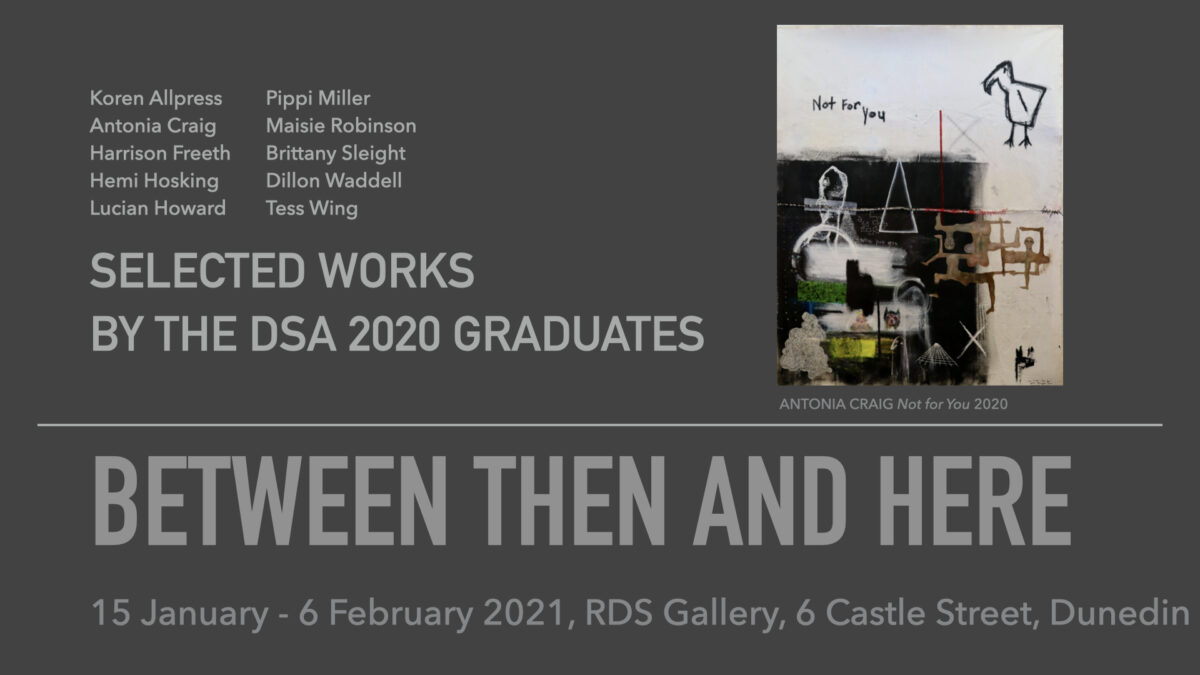
We begin 2021 with an exhibition featuring works from DSA 2020 Graduates selected by a panel of three anonymous referees, all established experts in contemporary art from the Dunedin community. The exhibition officially opens with a reception Friday 15 January, 5:30-7:00, closing Saturday, 6 February. Below a few comments by Alistair Fox on the forthcoming exhibition.
Between Then and Here: The Perspectives of a New Generation
In a year afflicted by a 100-year catastrophe – the Covid-19 pandemic – it might have been anticipated that artistic creativity would take a dive. To the contrary, the opposite is true, as proven by the works in this current exhibition, which represent some of the outstanding achievements of students graduating from the class of 2020 at the Dunedin School of Art. Their works speak to the role of artistic creation as a sociological and psychological necessity, and to the undiminished inventiveness of the next generation of this country’s artists.The range of media represented in this exhibition attest to the vitality of New Zealand art: screen prints, wood and plaster sculptures, pen and ink drawings, multimedia works, and digital prints, as well as paintings. More importantly, in terms of their thematic content, the works on display manifest an engagement by young New Zealanders with some of the most pressing concerns faced by this society. Chief among them are cultural issues, such as the need to come to terms with the unconscious bias implicit in the application of certain labels that have a racial implication (Hemi Hosking). Accompanying these concerns are others: nostalgia for a world that is changing (Dillon Waddell); concern for what is occurring in the borderlands between urban and rural (Lucian Howard); and awareness of the dysfunctionality of contemporary domestic life (Maisie Robinson). As far as the psychological dimensions of New Zealand life are concerned, these works reveal a preoccupation with the transition into adulthood (Tess Wing), including the experience of loneliness, dislocation, and depression (Pippi Miller). As such, these emerging artists hold up a mirror to this society in which it can contemplate the relation between what it has been and what it might be becoming or wish to become. A number of the artists extend 20th century aesthetic concerns into the 21st century, underlining the importance of art history to contemporary art. Koren Allpress interrogates colour theory, while Brittany Sleight reinvents Surrealist practices for the computer age. Again, harking back to the Surrealists, Antonia Craig conceives of painting as a means of engaging with the unconscious, while Harrison Freeth is preoccupied with the concept of play as a political act, echoing the historical avant-garde, in particular Dadaism.
Altogether, the works in this show suggest that the prospects for the future of art in this country are undiminished.
Alistair Fox, Dunedin, January 2021
.
GALLERY CLOSED
Wednesday 23 December – 6 January
We re-open Thursday 7 January 11-5:30
RDS Gallery, 6 Castle Street, Dunedin
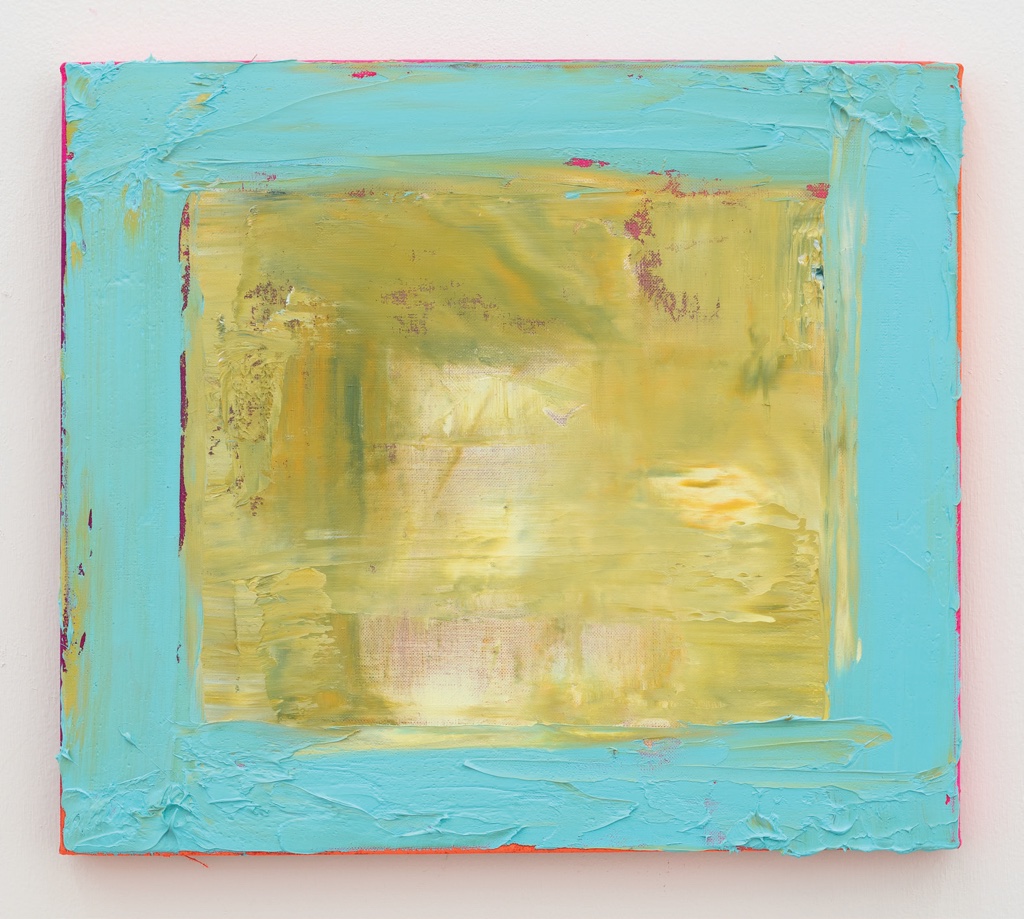
Reception for Michael Greaves
Friday 13 November 5:30–7
RDS Gallery, 6 Castle Street, Dunedin
Join us for a reception in honour of Michael Greaves on the occasion of his exhibition “I Suddenly Remembered My Grandmothers’ Words”. All those who support art and artists are welcome.
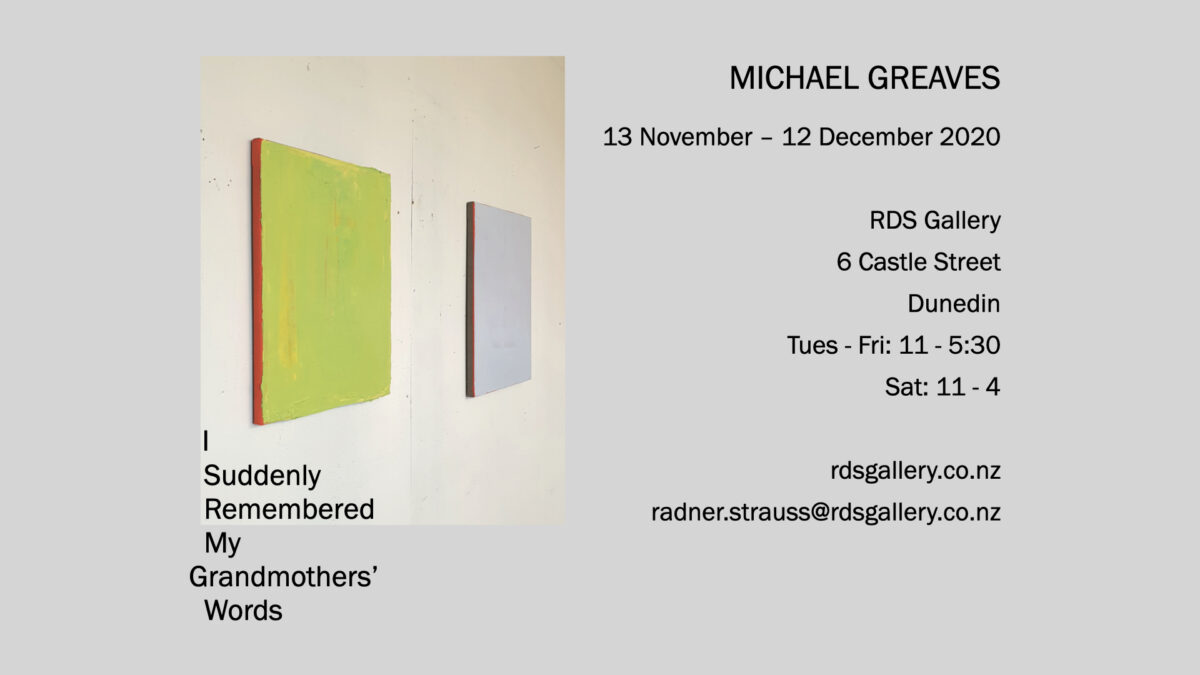
Michael Greaves
I Suddenly Remembered My Grandmothers’ Words
13 November – 12 December 2020
Born in 1976 and a native of Dunedin, Michael Greaves exhibited a facility for drawing and painting while still an adolescent, which garnered him attention, praise and even sales. While this early initiation undoubtedly fuelled his desire to become an artist, much of his subsequent work as painter over the past twenty years has revolved around exploring what painting might be once it throws off the burden of representing reality in accordance with what and how we see. In a 2012 essay, Greaves wrote: ‘For me, this “window to the world” idea of painting, a mode so similar to the ubiquitous photograph, does not accurately present the position that painting occupies, although it was the pathway and the projected road to a successful painting promoted during my early years, emphasising correctness to the representation of sight.’ In the works included in his solo exhibition with RDS Gallery, which runs 13 November–12 December, Greaves has pushed this process of reflection and enquiry still further, largely omitting any suggestion of representation as a literal transcription of a visually perceived object. Instead, he has allowed the formal properties of the work (shape, colour, line, texture, etc.), in combination with titles that are designed to trigger reflective speculation on the part of the viewer, to convey his sense of the ‘more’ that resides beyond the constraints of figuration as ‘representation’, both on the part of the artist who creates the painting, and the viewer who looks at it.
Greaves currently holds the position of Senior Lecturer in Painting, Dunedin School of Art, Otago Polytechnic, where he has taught for the past fifteen years. He holds a Bachelor of Art (Painting) and Master of Fine Arts from the Dunedin School of Art, Otago Polytechnic, as well as a Bachelor of Arts, majoring in Art History and Theory, and a Bachelor of Education (Secondary) from the University of Otago.
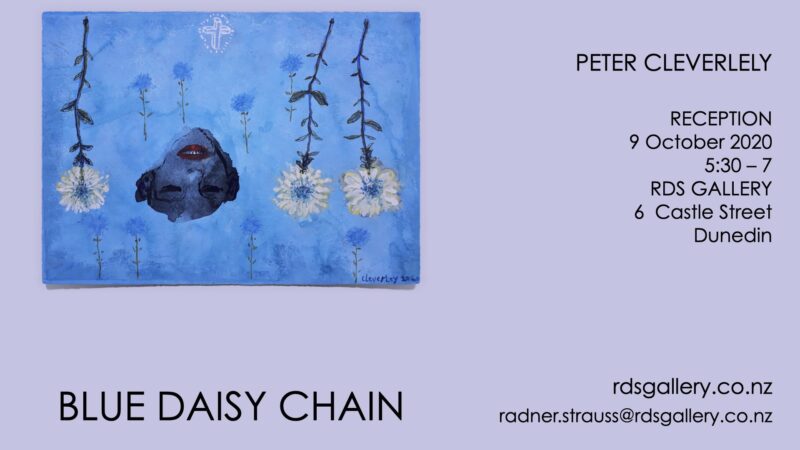
Peter Cleverley: BLUE DAISY CHAIN
7 October – 9 November 2020
Peter Cleverley: BLUE DAISY CHAIN, RDS Gallery, 6 Castle Street, 9 October – 7 November 2020
Peter Cleverley has secured himself a place in the history of New Zealand art: for over thirty-five years he has been painting in his native Oamaru, where the great New Zealand writer Janet Frame spent the majority of her childhood. Peter continues to create in a tiny studio located in Kakanui, whose variegated skies, blue seas and ‘horseshoe bluff’ mark his work, providing, along with his many travels, ‘the matrix’ for his art, in the words Hal Smith, writing for Art New Zealand in 1988. Peter is indeed a regional artist in the sense that he is of the region, ‘a product of our own patch of earth’, again in the words of Hal Smith. His concerns are, nonetheless, global, as he continues to explore what he calls ‘the human condition’ in all its complexities.
His exhibition BLUE DAISY CHAIN, running from 9 October – 7 November at RDS Gallery, 6 Castle Street, Dunedin, offers the viewer a set of paintings produced within a specific time period by an artist dans la force de l’âge – at the height of his powers, enriched by long years spent refining his craft. The subject matter derives from his memories, ‘blue daisy chain’ (the painting which gave the exhibition its title), for example, referring to his childhood activities. ‘ALL TWENTY NINE’, a reference to the Pike River Mine victims of 2010, arises out of a national trauma, while ‘knitted flowers – Bangkok’ conjures up an encounter the artist had in Thailand with a young woman selling ‘knitted flowers’ from her wheel chair. In contrast ‘Jimi Hendrix Experience with a vase of flowers’ evokes the eponymous singer who died tragically from an overdose at the age of 27––and the music of Peter’s youth. The deeply affective nature of these renditions owes much to the fact that this artist has mastered his medium – in particular, he is a colourist of unrivalled virtuosity, painting frequently in gouache and water colour, with the finished work hovering undefinably between figuration and abstraction.
PETER CLEVERLEY, blue daisy chain (2020). Medium: gouache & water colour on Bockingford paper. Dimensions: hght 275mm x wdth 380mm
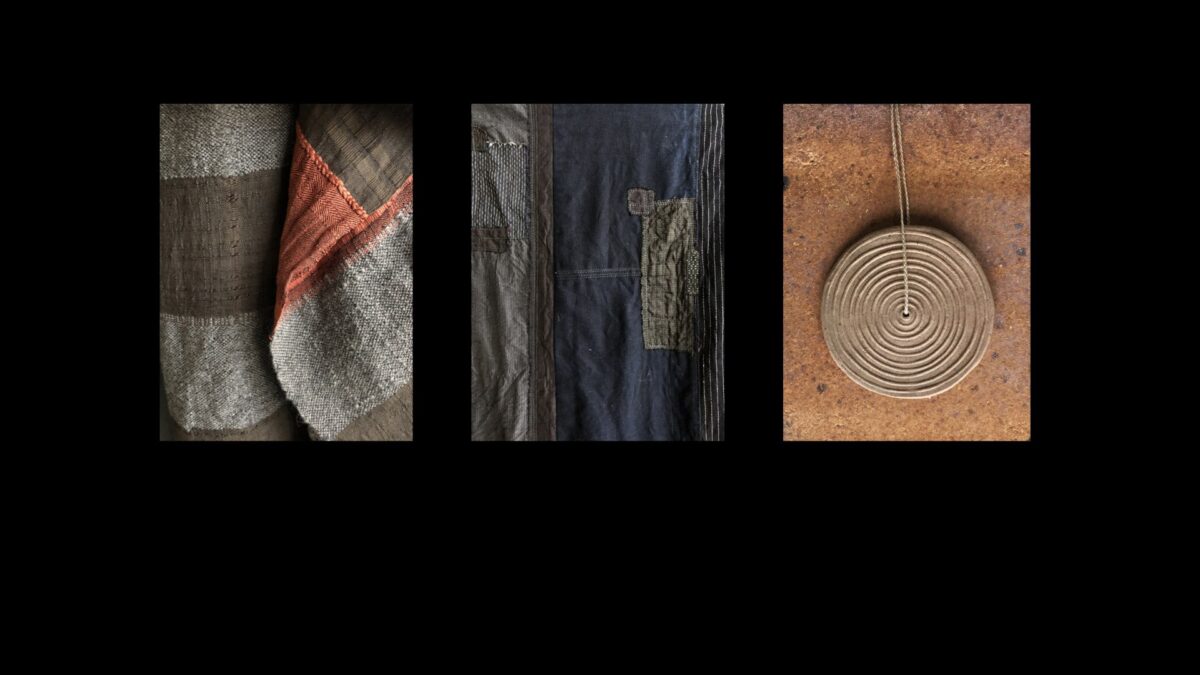
‘Christopher Duncan and Joseph Yen with Kate Fitzharris: Trusting Our Hands’ on view at 6 Castle Street 11 September – 3 October
Thurs, Fri: 11-5:30; Sat 11-4
Christopher Duncan and Joseph Yen, both hailing from Auckland, bring the art of what textile scholar Jane Malthus describes as “geometric abstraction” to their “cloths and garments”. These creations are complemented by the work of Dunedin ceramics artist Kate Fitzharris, including a set of hand-formed necklaces. For Kate, “objects … can contain something of our experiences, our memories of the past or our hopes of the future”. All three artists are concerned with the way the art object has the potential to become part of our daily life – in Malthus’ words, they are “dedicated to slowing the mad pace of city life that has lost touch with natural rhythms”. They ask us to observe our surroundings, including the clothes that cover us and the objects with which we live – to question the nature of an ever-proliferating mass-produced consumer culture, divorced from human touch, by offering an alternative. Joseph Yen comments: “When a piece is hand-made and not mass-produced, every single piece is different. I think something you use every day should be beautiful.” He further elaborates: “The clothing that we make…it’s not mass-produced; we make each one ourselves, so you can call it an art piece.”
Christopher Duncan, one of the most prominent weavers of his generation, has exhibited extensively in New Zealand, including the Pah Homestead, and Objectspace. He was awarded Dame Doreen’s Gift (Blumhardt Foundation) in 2018. His work is held in the collection of Auckland Museum Tamaki Paenga Hira. Joseph Yen, in addition to practicing his own craft constructing unique pieces of clothing and jewellery, runs a small gallery, Tür, on Karangahape Road. Kate Fitzharris is an award-winning ceramicist. Her honours include a recent residency at Shigaraki Ceramic Culture Park (Japan, 2019), with funding provided by the Blumhardt Foundation and Creative New Zealand.
Peter Cleverley, exhibiting with RDS Gallery 9 October – 7 November, is speaking at the Dunedin School of Art on 10 September.
THURS 10 SEP, 12.00 – 1.00 PM, P152, DUNEDIN SCHOOL OF ART, RIEGO ST, DUNEDIN
Peter Cleverley
fourteen pictures with fourteen words
Peter states: “I will show photographs of recent paintings being prepared for exhibitions in Dunedin and Christchurch, October 2020, and discuss some of the influences, techniques, concepts and ideas used to bring them about.”
Peter Cleverley was born in Oamaru (1954) and awarded a Diploma in Fine Arts from the Dunedin School of Art in1974. He has travelled the world: Aotearoa, Australia, Indonesia, Europe, Turkey, Iran, Afghanistan, India, Thailand, Laos, Polynesia, working at anything that would support his art making. Returning to Aotearoa in 1984 Peter has continued paint and exhibit nationally. He worked as the Exhibitions Officer from 1985 – 1997at the Forrester Public Gallery in Oamaru and Lectured in Painting and Drawing at the Dunedin School of Art from 1998 to 2017.
His paintings are held in permanent collections of municipal galleries including Te Papa, the Dunedin Public Art Gallery and the Forrester Gallery. Since 2017 he has worked full-time painting at his studio in Kakanui.
JUSTIN SPIERS: BEFORE THERE WAS HOPE
On view at 6 Castle Street
14 August through 5 September
Thursday 11-5:30
Friday 11-5:30
Saturday 11-4:00
Photographer Justin Spiers, currently located in Dunedin, has a long-standing interest in documenting and exploring the relations between humans and their environment, especially, but not exclusively, with regards to the other animals that share their planet.
He is perhaps best known for “Pet Photo Booth”, initiated in 2005 with Yvonne Doherty while he was Director of the Perth Centre for Photography, a position he held from 2004-2007. Works from the “Pet Photo Booth” project have been widely exhibited, including at the National Portrait Gallery (Canberra, Australia) in 2009, the Perth Institute of Contemporary Art and the Australian Centre for Photography in 2012, as well as at the Pah Homestead in Auckland, which houses the James Wallace Art Trust’s collection of New Zealand art, in 2019.
Spiers’ photographic works investigate the ecological complexities of contemporary human experience and activities:“Castlelands” (The Blue Oyster, 2011) records the architectural intersections between fantasy, domesticity and nature, while the photographs included in “The Colony” (Christchurch, 2016) take up issues arising out of the larger environmental context. Further exhibitions including “The Sides of My Intent”, at the a gallery, Dunedin, in 2012; Zoo Series exhibited as part of Hijacked III (Perth Institute of Contemporary Arts) also in 2012; and “Meat Fence,” another project that resulted in a 2014 exhibition at the Perth Centre for Photography with Jonathan Marshall––all served to invite viewers to reflect on the more difficult and vexed aspects of humans’ relations with other animals.
One of Spiers’ collaborators, Jonathan Marshall remarks that “Neither Justin nor I can fully decipher what these animals stand for. They are enigmas that in the end can only reflect back our own compromised gaze like a dull, opaque mirror.” Not surprisingly, then, Justin Spiers’ exhibition at RDS Gallery, which runs from 14 August – 5 September 2020, returns to many of these themes––the connections between humans and other animals, their representations and their implications––the broader ecologies that define their lives.
Sources––Jonathan W. Marshall, “Trophies Remain”, Performance Research: A Journal of the Performing Arts 22.8 (2017): 86-98.
Exhibition extended through 8 August.
This July, we are very pleased to be exhibiting:
Folk Art of the
Apocalypse:
PETE WHEELER
3 July – 1 August
6 Castle Street
Recently, on the occasion of an overview of the artist’s work held by the Wallace Arts Trust collection, spanning the years 2004-2019, Sir James Wallace remarked that Pete Wheeler ‘is by no means as well-known in New Zealand as he should be. In fact, he is recognised much more in Berlin and Florence, where he had a major exhibition in 2011’. Exceptionally, ‘Folk Art of the Apocalypse’ makes available to inhabitants of Dunedin a set of new works by this significant painter. While he, his wife and three children currently reside in Berlin, they were caught out by the nationwide lockdown, which they spent in Broad Bay, where a number of these new paintings were created.
Born 1978, in Timaru, New Zealand, Pete holds a BFA (2000) from the Otago Polytechnic and ‘describes Dunedin as his “home city “…. Dunedin is where he returns to and where many of his good friends live’ (ODT, 25 June 2020). He has exhibited widely in New Zealand and internationally in galleries such as Buia Gallery, NY, Jonathan Smart Gallery, Christchurch, Poggiali e Forconi, Florence, and Whitespace Gallery, Auckland. Alistair Fox describes ‘Folk Art of the Apocalypse’ as a response to the coronavirus pandemic, emerging out ‘an enforced lockdown…the paintings in this exhibition being either created during the lockdown, or else presented to be viewed in the context of the pandemic’. In Fox’s terms, they serve to underline ‘a generational failure..the failure of the older generation to provide a world in which the young can thrive’ (exhibition catalogue).
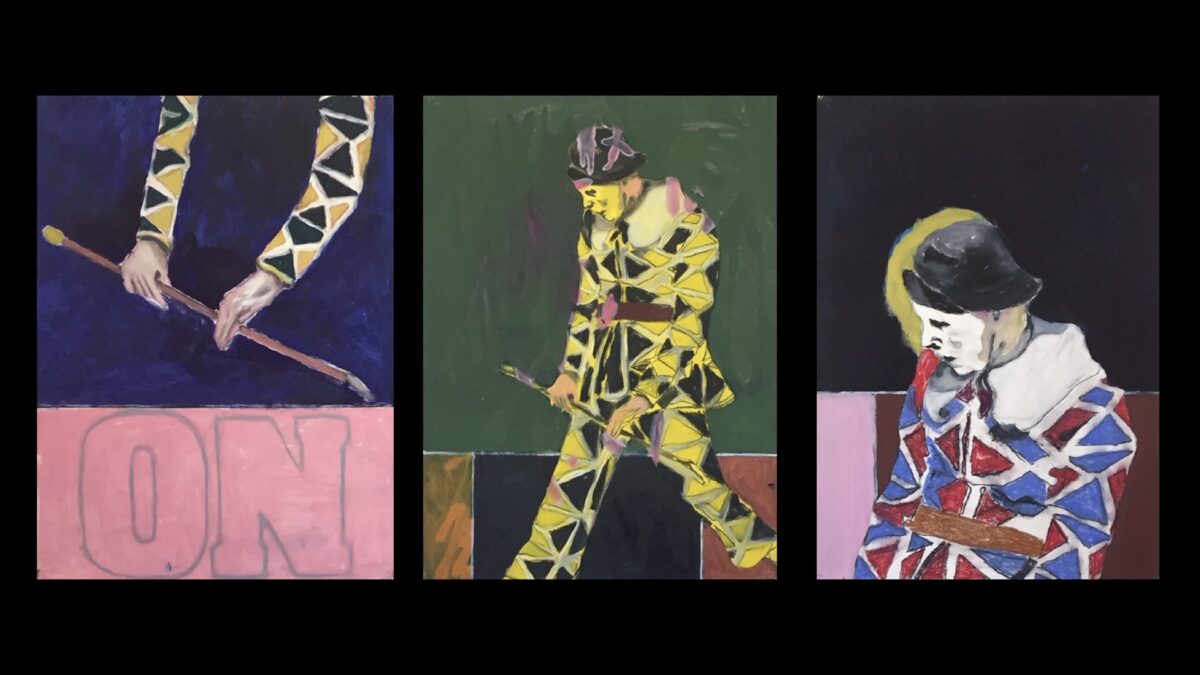
RDS Gallery will be hosting a solo exhibition of paintings by Pete Wheeler, 3 July -1 August 2020.
Peter Wheeler (b. 1978, Timaru, New Zealand) holds a BFA (2000) from the Otago Polytechnic and an MFA (2009) from the U of Canterbury. He has exhibited widely in New Zealand and internationally in galleries such as Buia Gallery, NY, Jonathan Smart Gallery, Christchurch, Poggiali e Forconi, Florence, and Whitespace Gallery, Auckland. He currently resides in Berlin with his wife and three children.
Wheeler’s primary engagement is with painting as an activity that seeks no other justification outside itself. He works exclusively in oil on canvas, which he primes with rabbit skin glue on the reverse. He specifies: ‘Somehow, I just love putting colour on a surface. It’s just the way it is. I think art is just something inherently in us as kids, and some of us carry that through life’. His later paintings are often developed with reference to found photographs, which he re-interprets liberally; he is drawn to a particular image (to which he frequently returns more than once) because of the way it suggests a potential painting as a play of colour, texture, form and composition . His work remains, nonetheless, largely figurative and fundamentally enigmatic. He comments that ‘I am interested in a narrative that considers the relationship between our reality and the metaphysical’; yet, he steadfastly refuses to elaborate on the nature and import of that relationship––leaving that task to the individual viewer.
References
Bruni, Lorenzo. ‘Conversation between Lorenzo Bruni and Pete Wheeler’. In Pete Wheeler, Lorenzo Bruni, ed. Florence: Galleria Poggiali e Forconi, 2011.
Sisterson, Craig. ‘pushing paint around’, latitudemagazine.co.nz. Consulted https://thecentral.co.nz/usr/library/documents/main/101/pete-wheeler-latitude-mag.pdf
Images: PETE WHEELER, Trojan Horse (2019), oil and oil stick on canvas, 220cm x 170cm; PETE WHEELER, Looking for My Own Name (2019/20), oil and oil stick on canvas, 200cm x 150cm
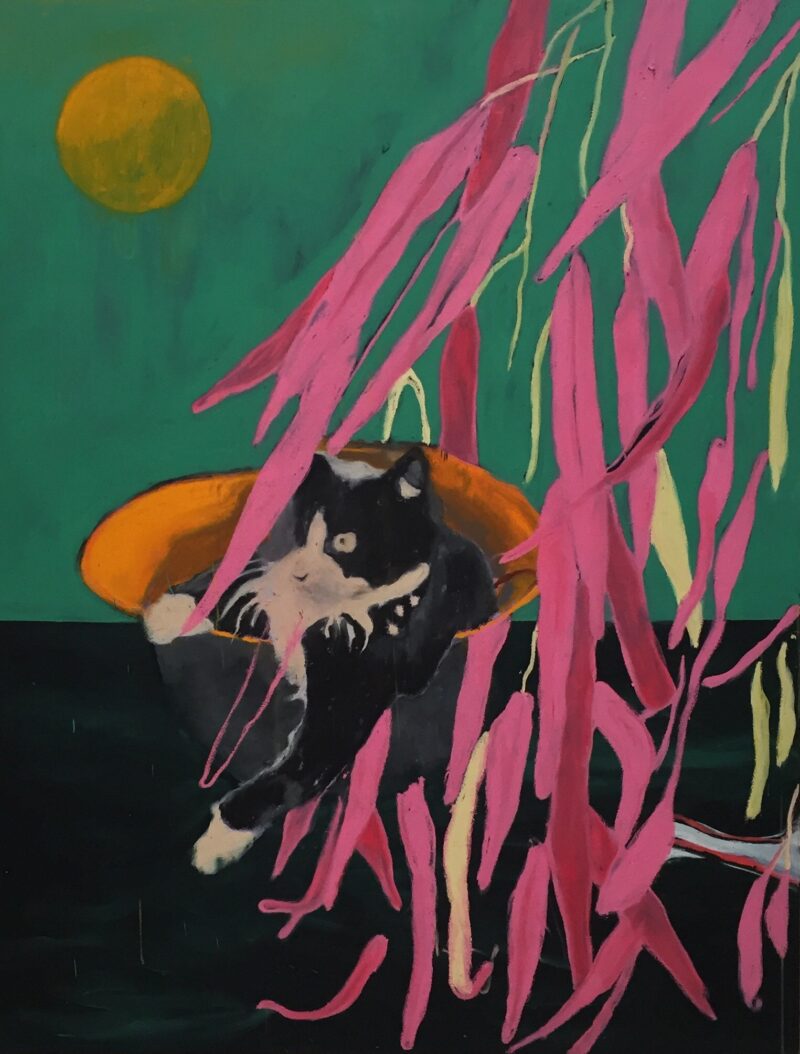
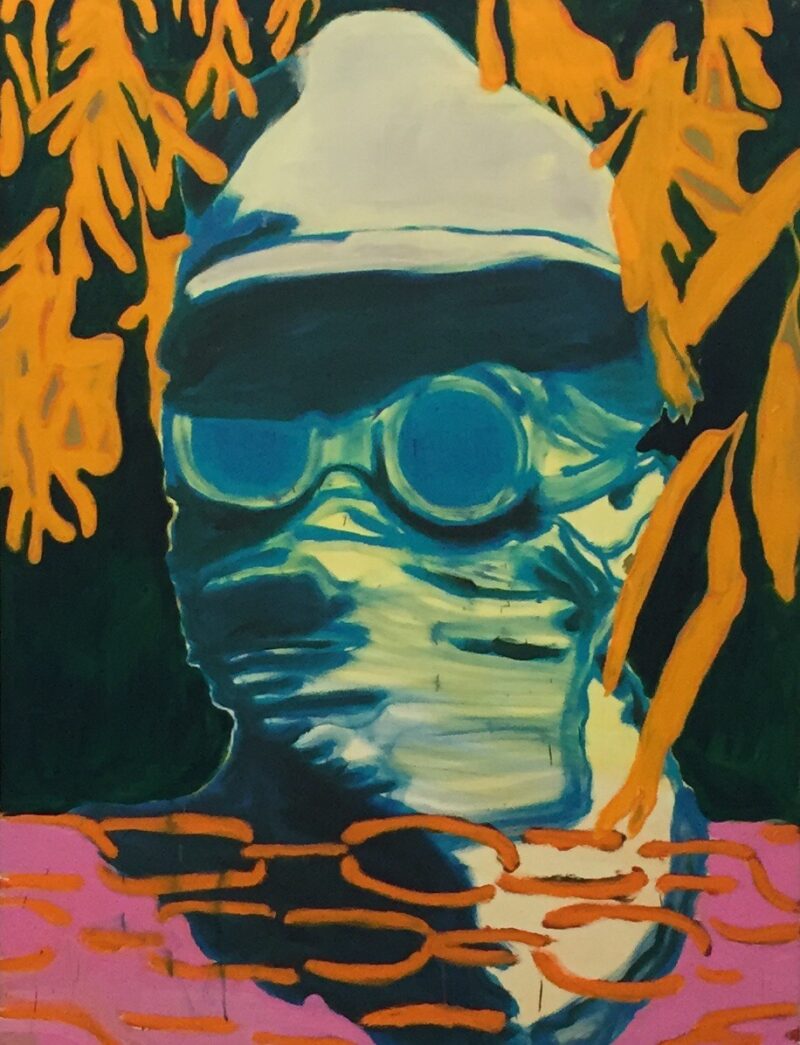
Exhibition Schedule
May – December 2020
Philip Jarvis, Felix Harris, Pete Wheeler
8 May – 30 May
Madeleine Child
4 June – 27 June [official opening Friday 5 June]
Pete Wheeler
2 July –1 August [opening reception Friday 3 July]
Justin Spiers
13 August –5 September [opening reception Friday 14 August]
Christopher Duncan and Joseph Yen with Kate Fitzharris
10 September – 3 October [opening reception Friday 4 September]
Peter Cleverley
8 October – 7 November [opening reception Friday 9 October]
Michael Greaves
12 November – 12 December [opening reception Friday 13 November]